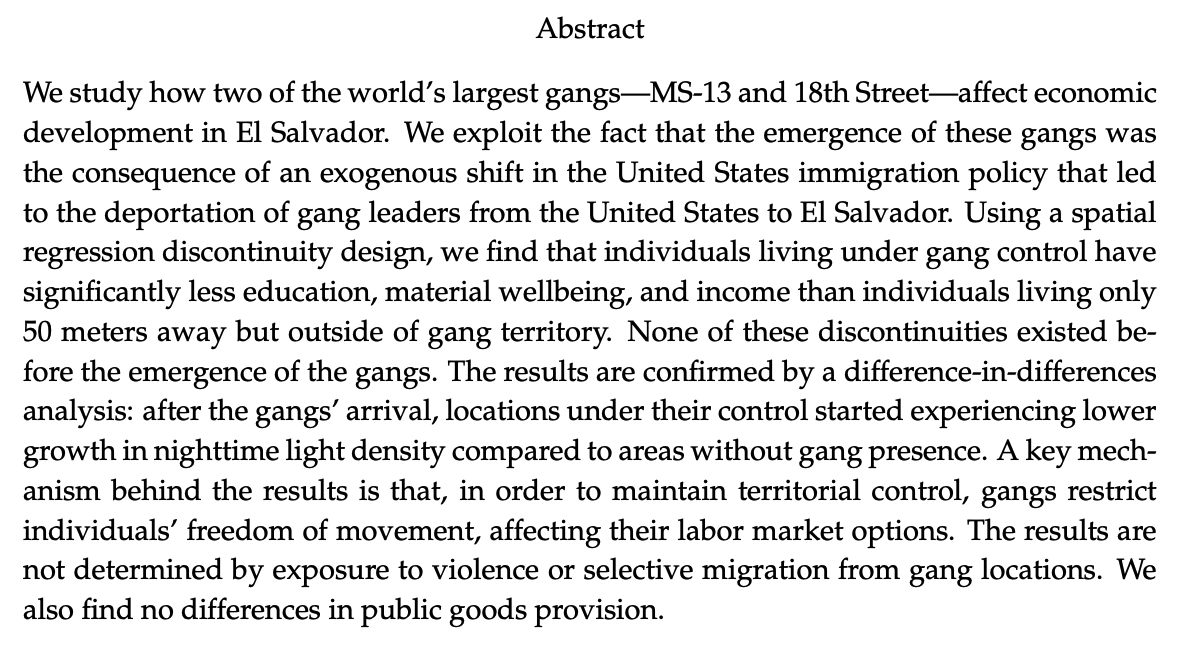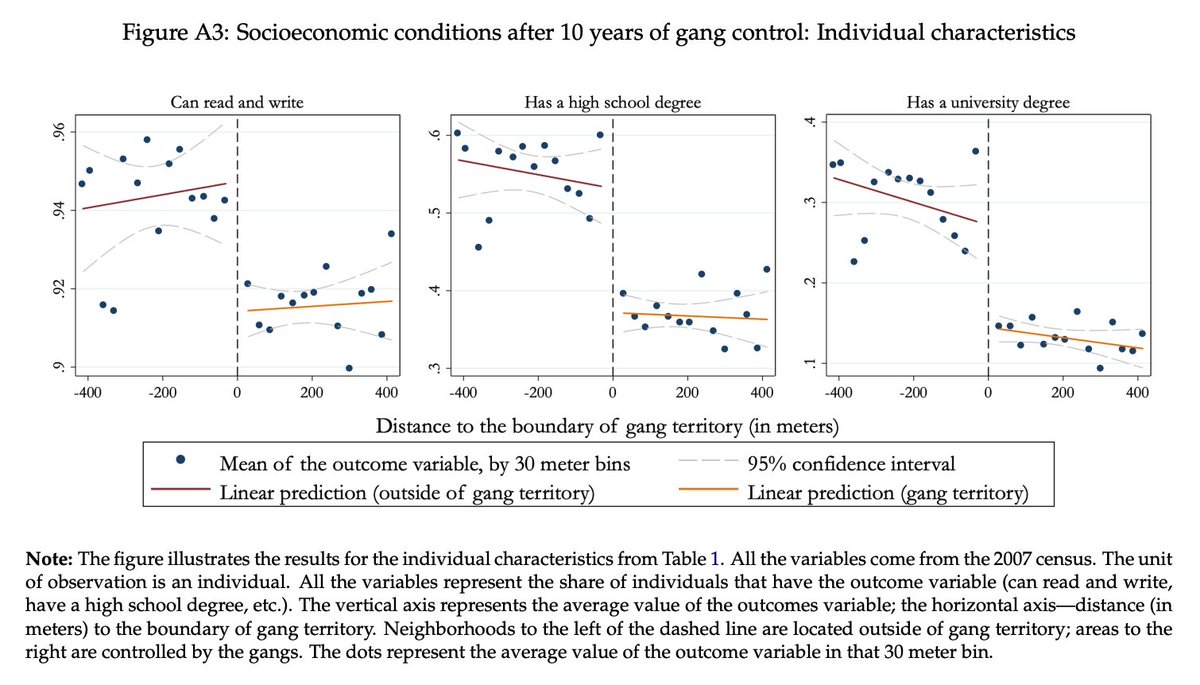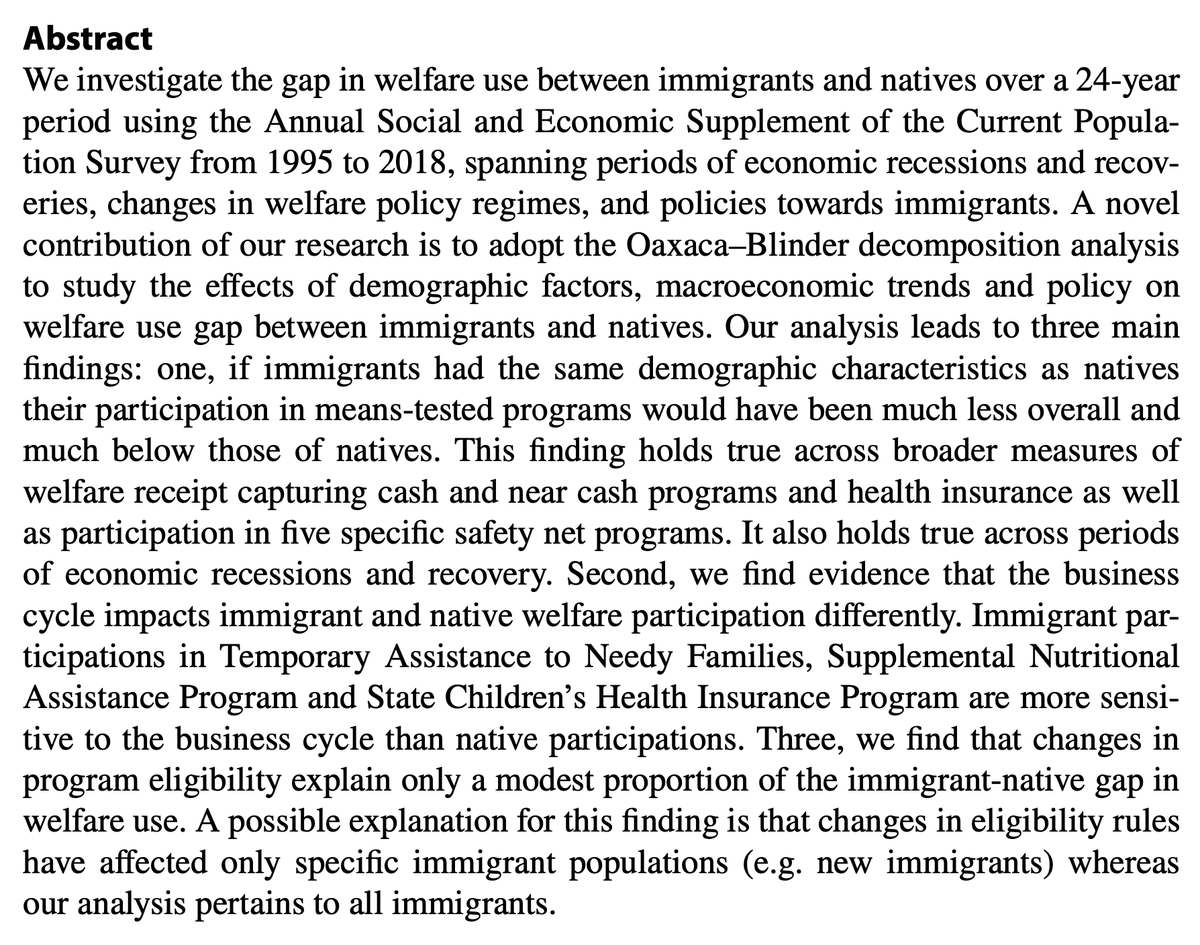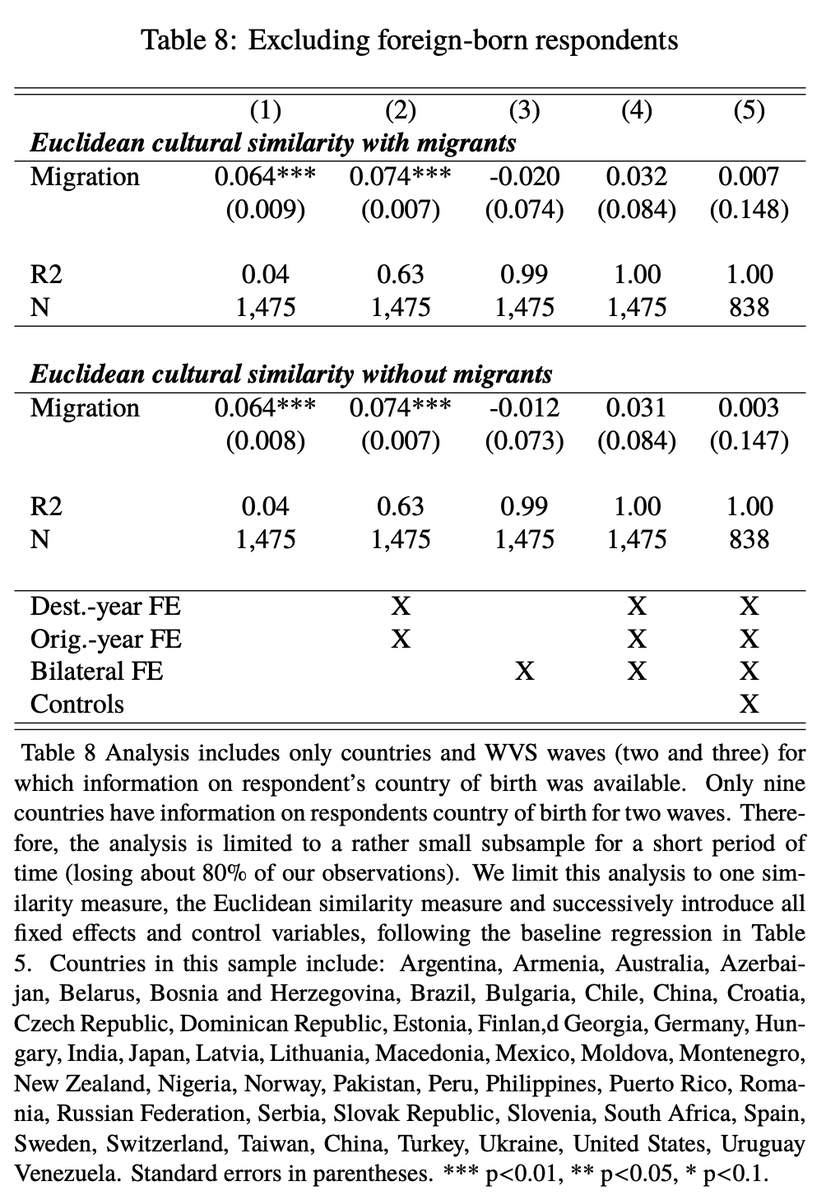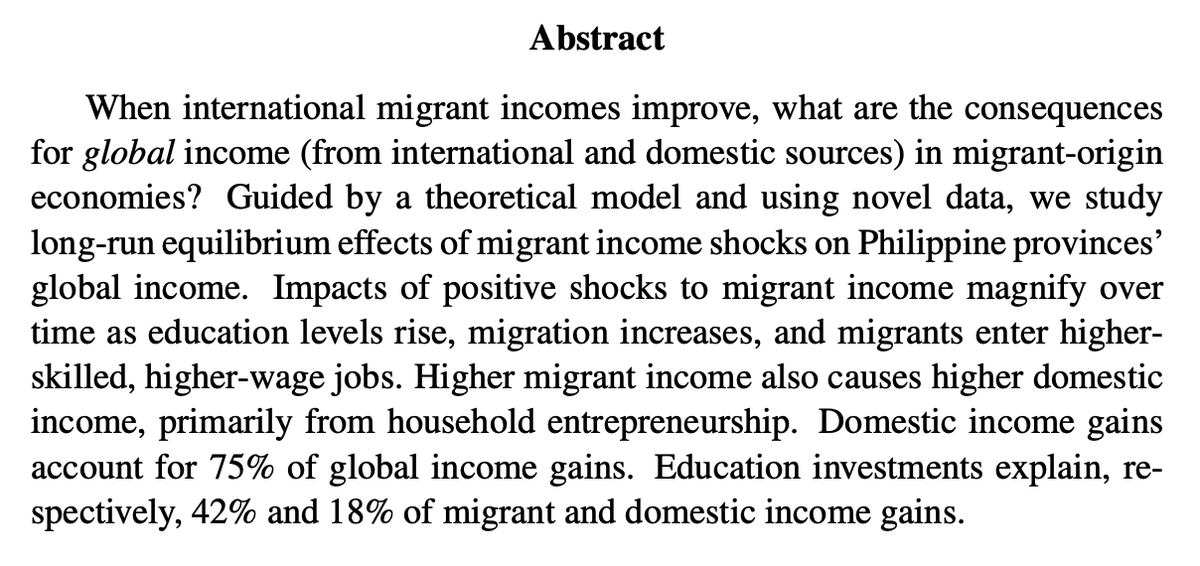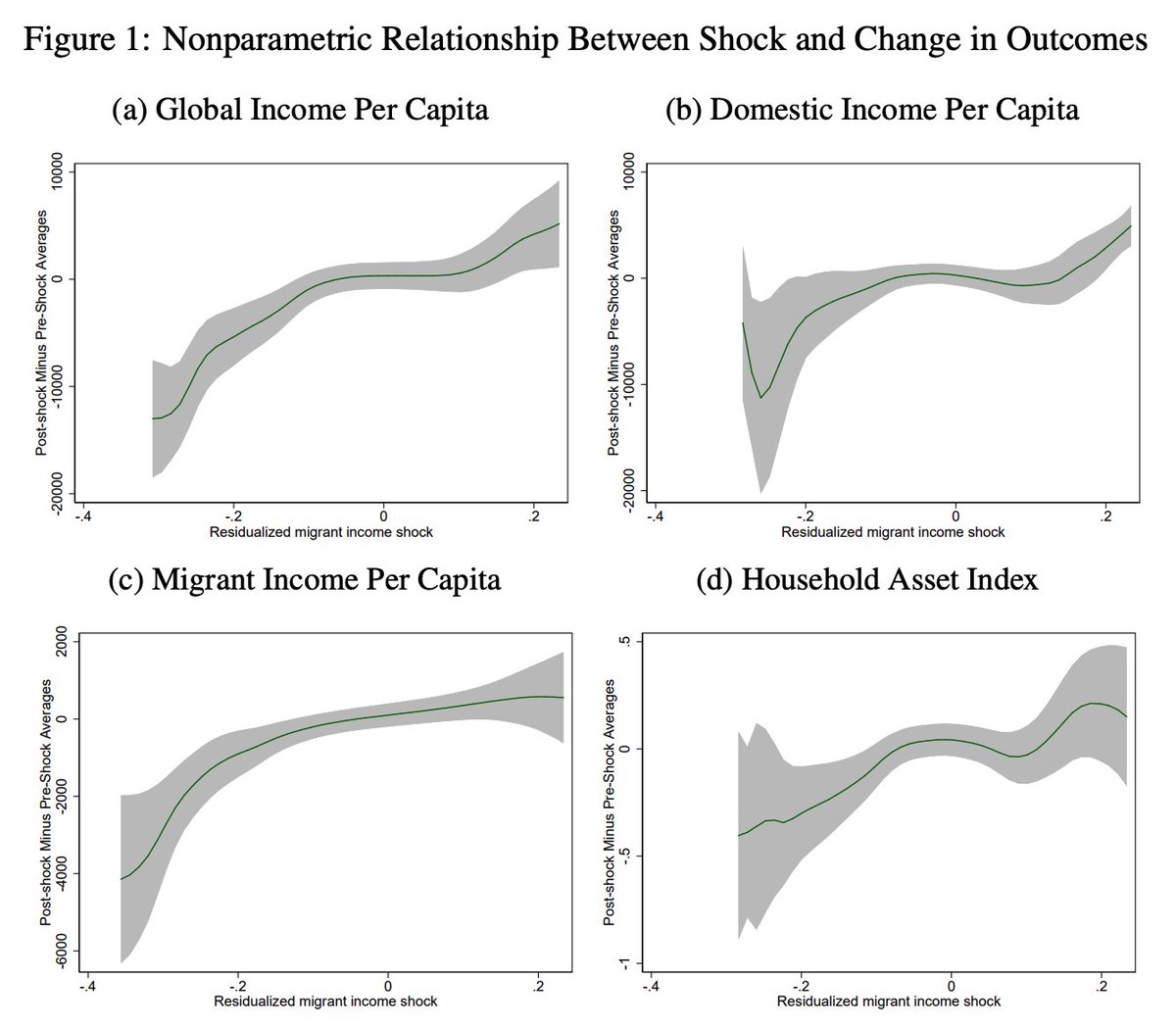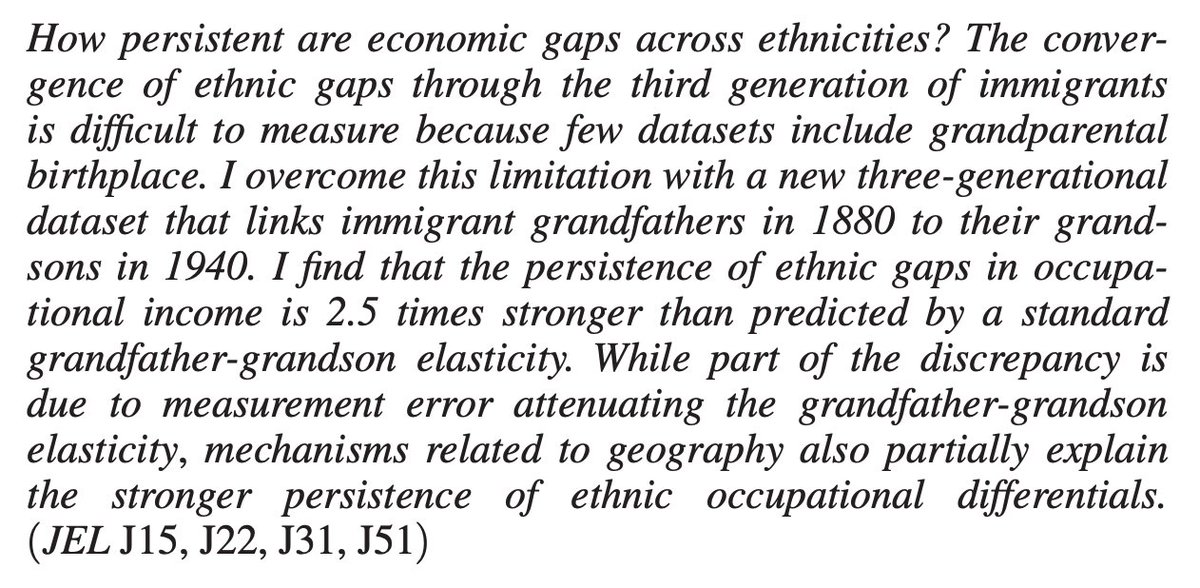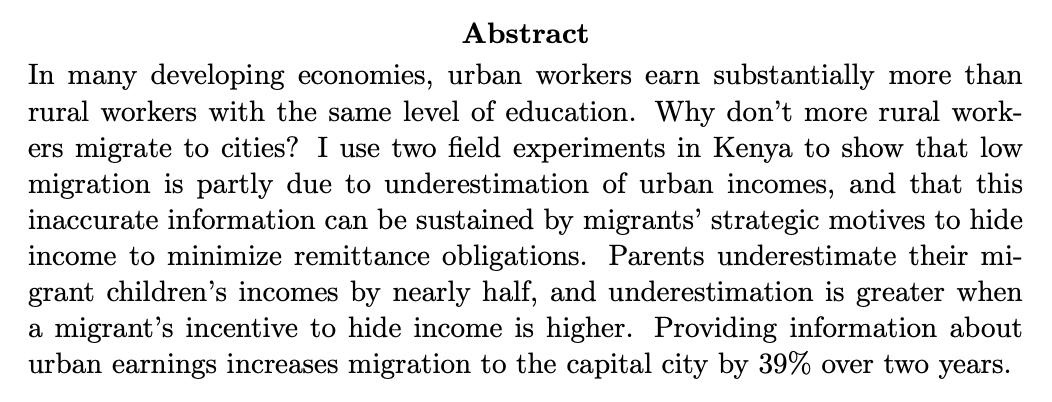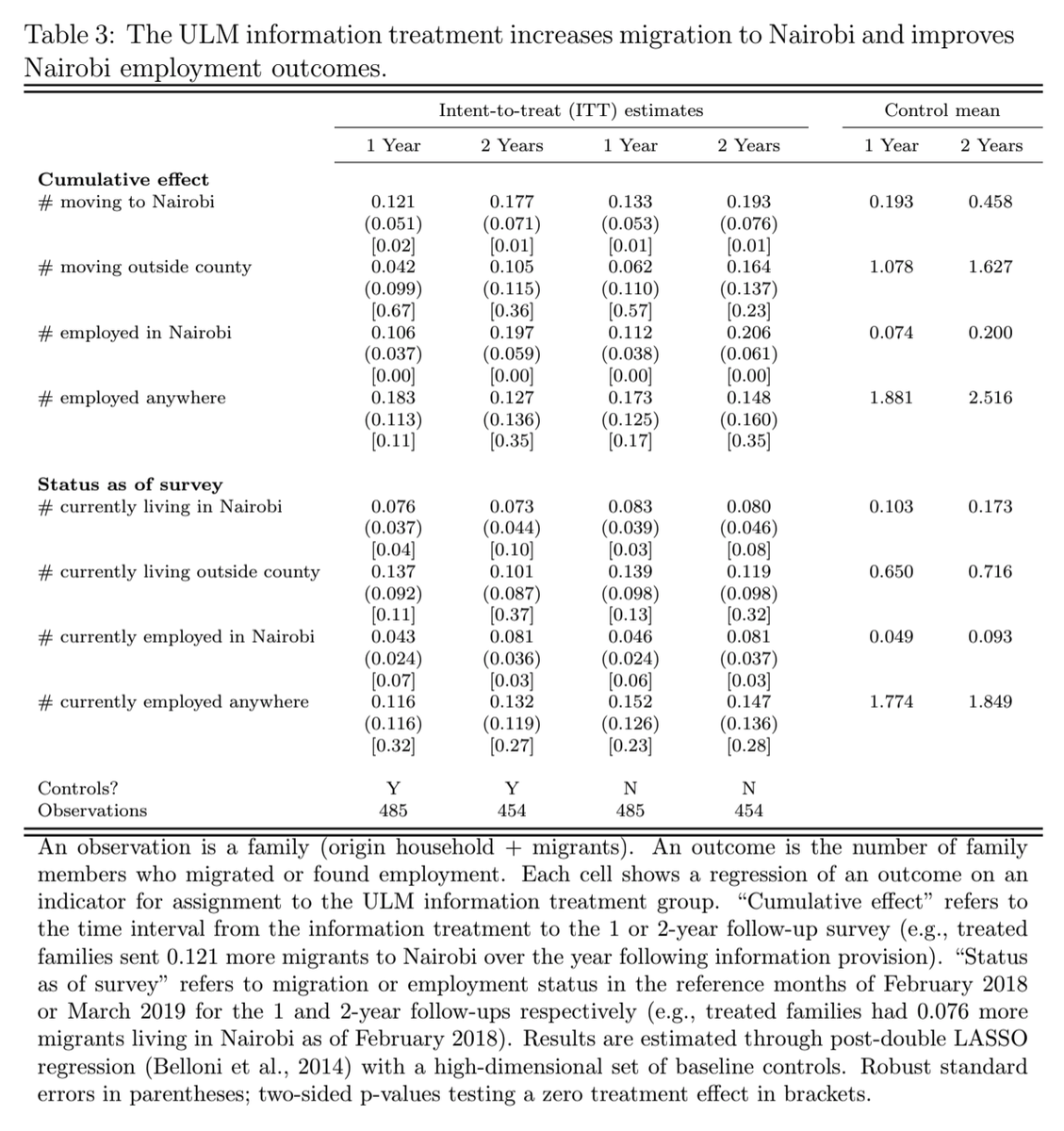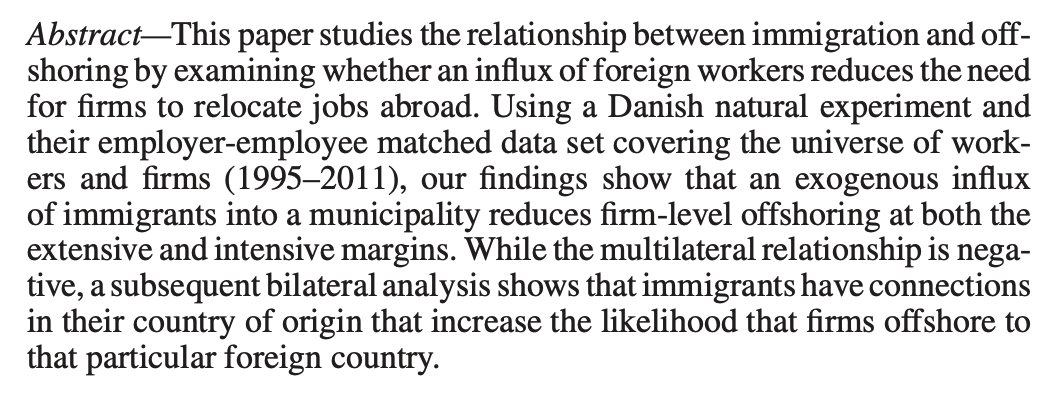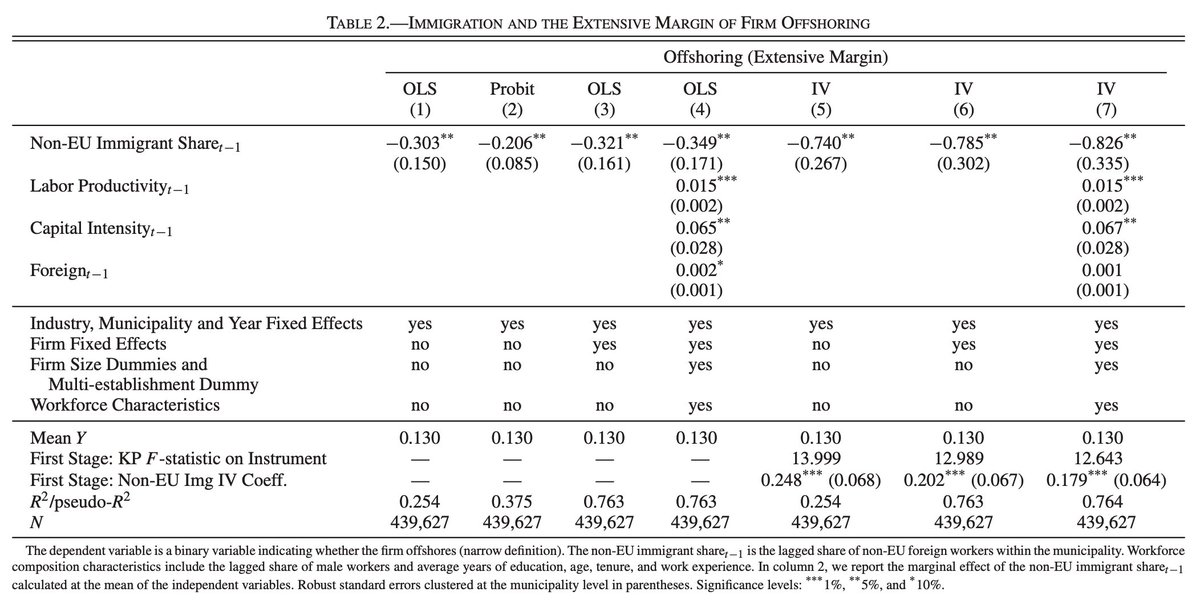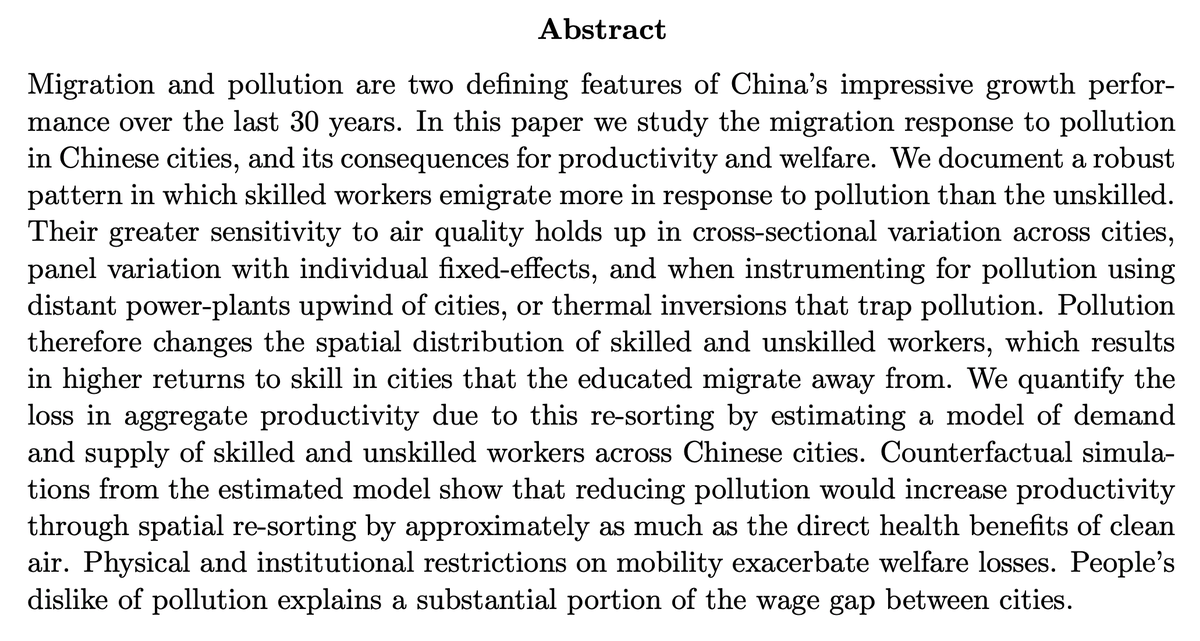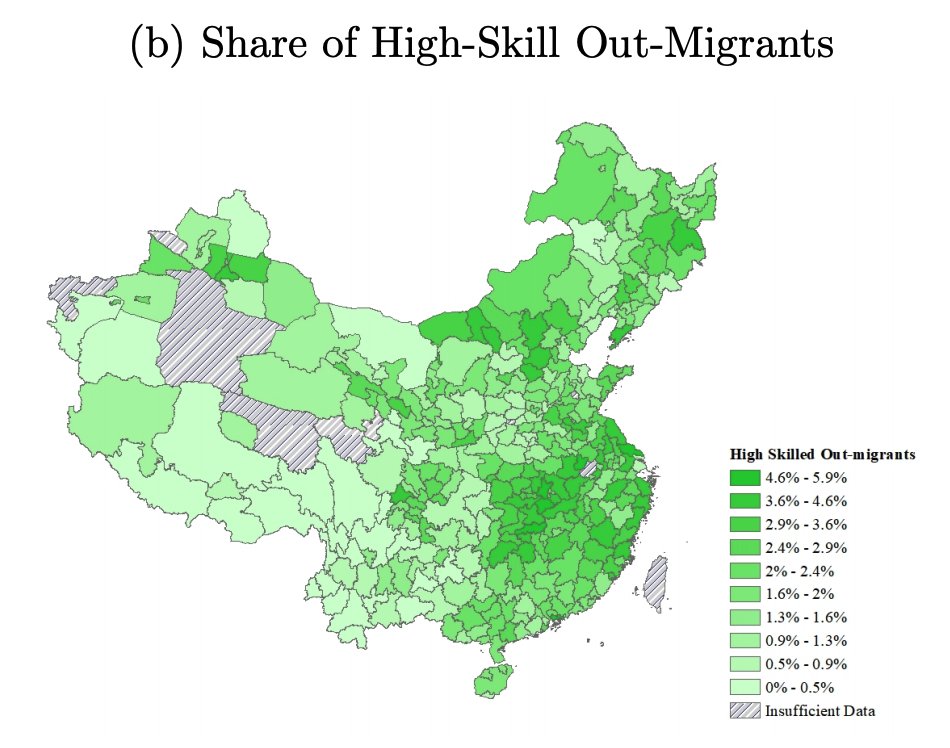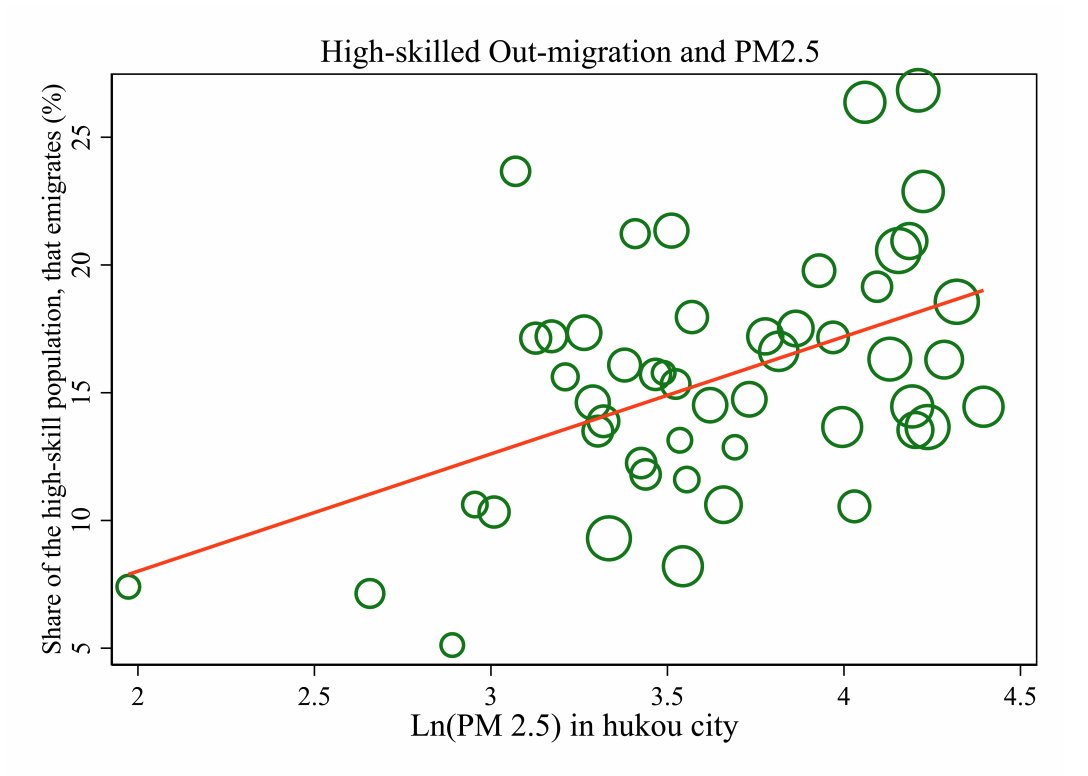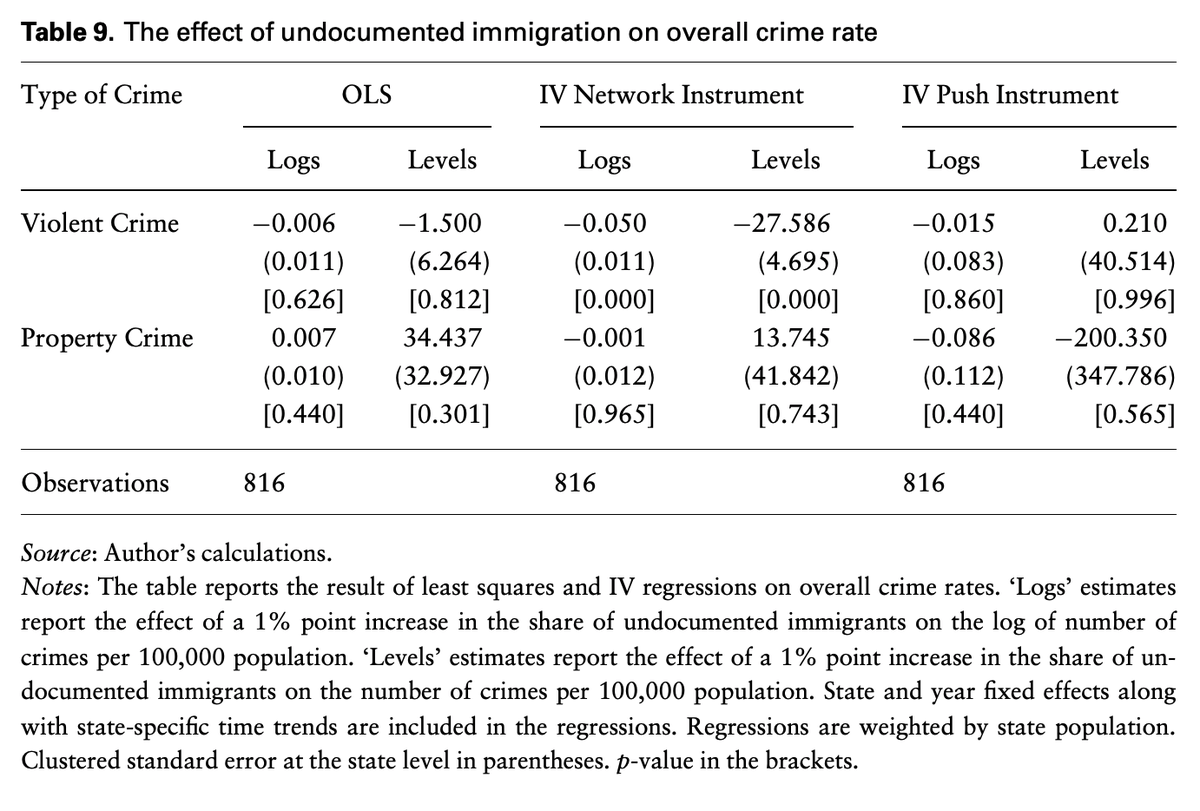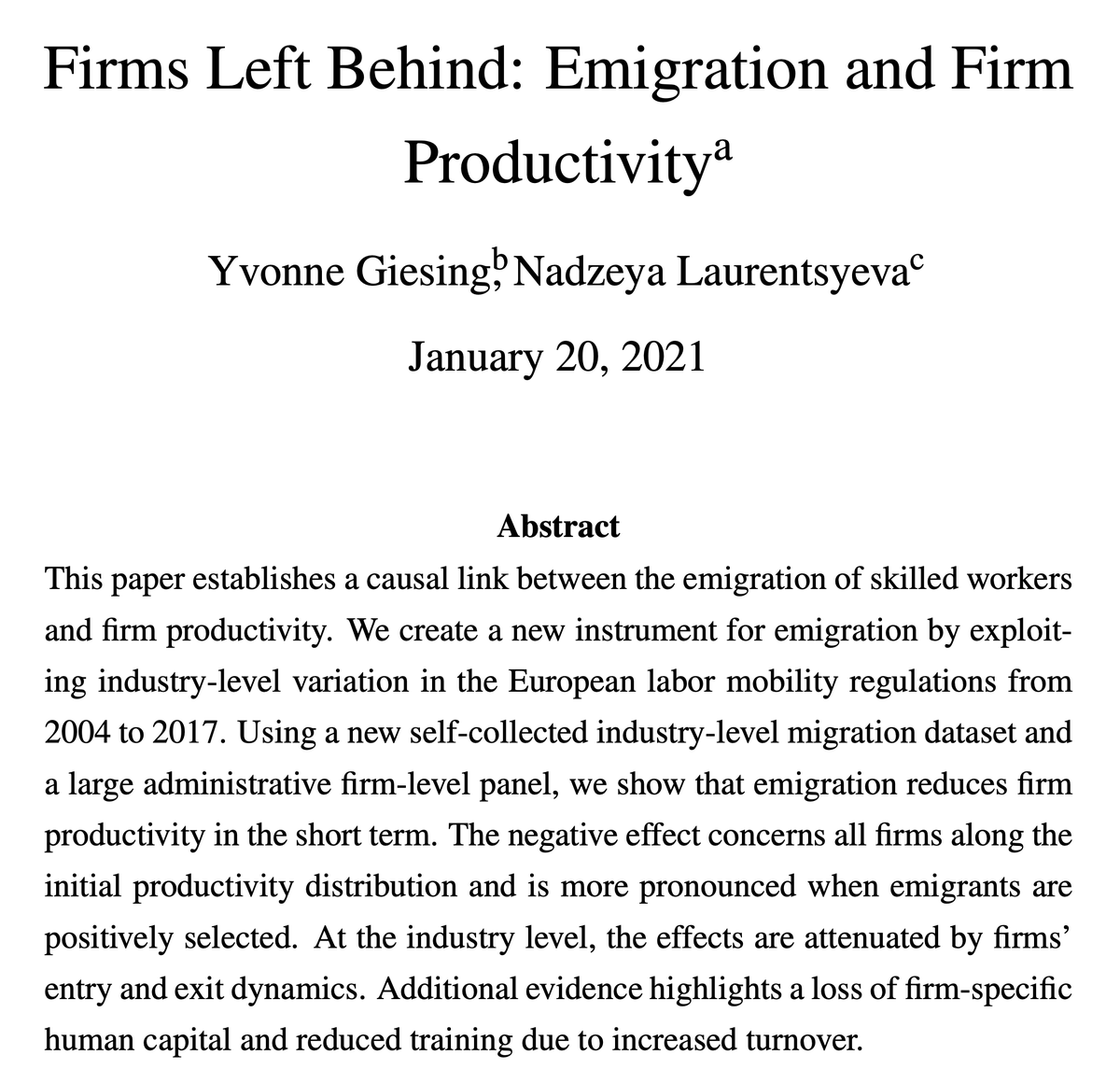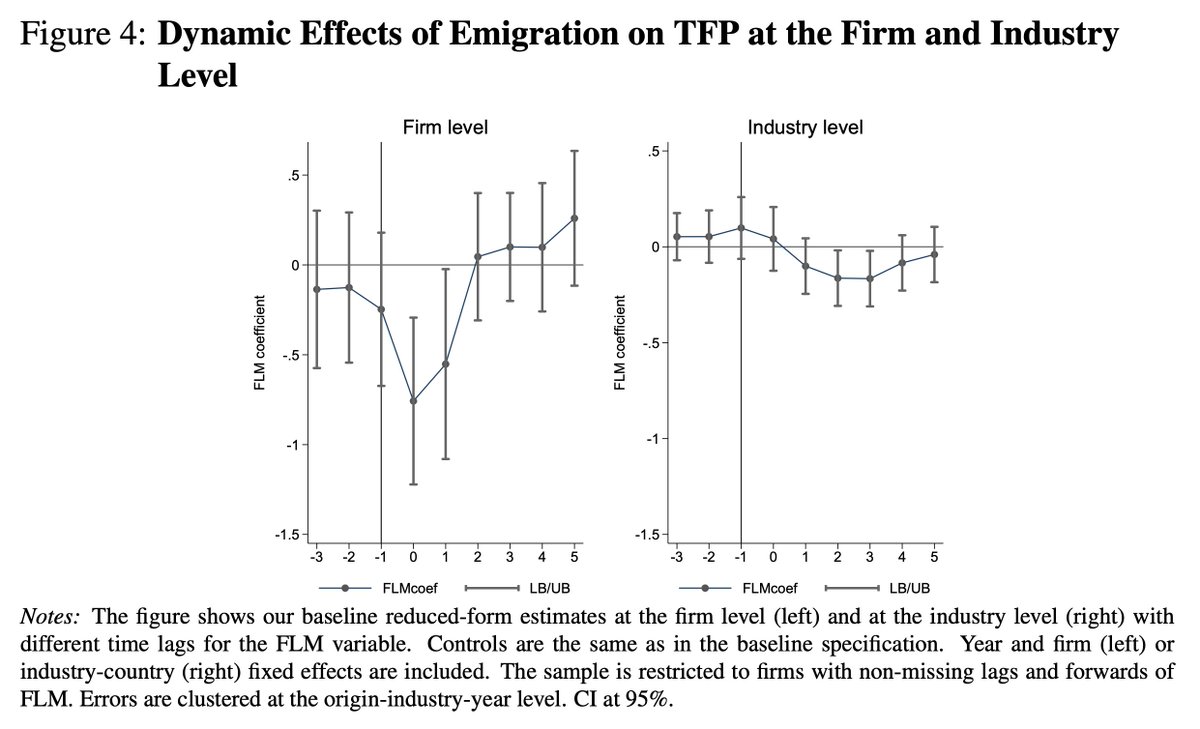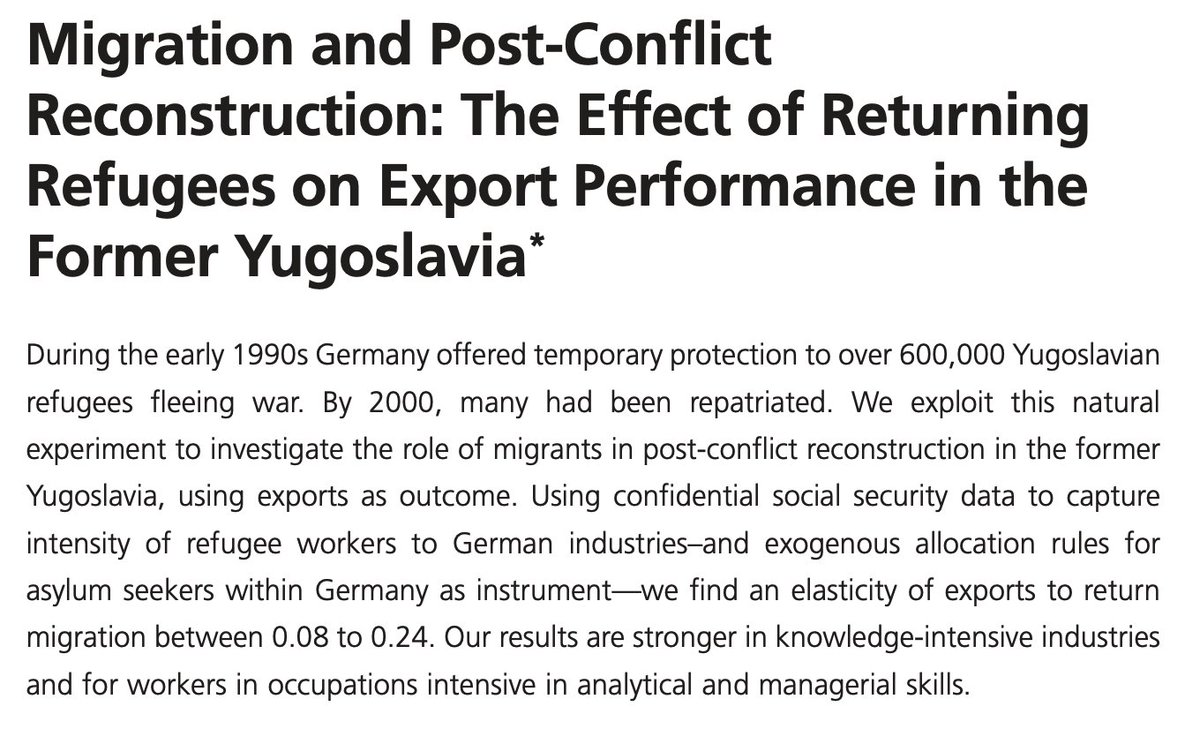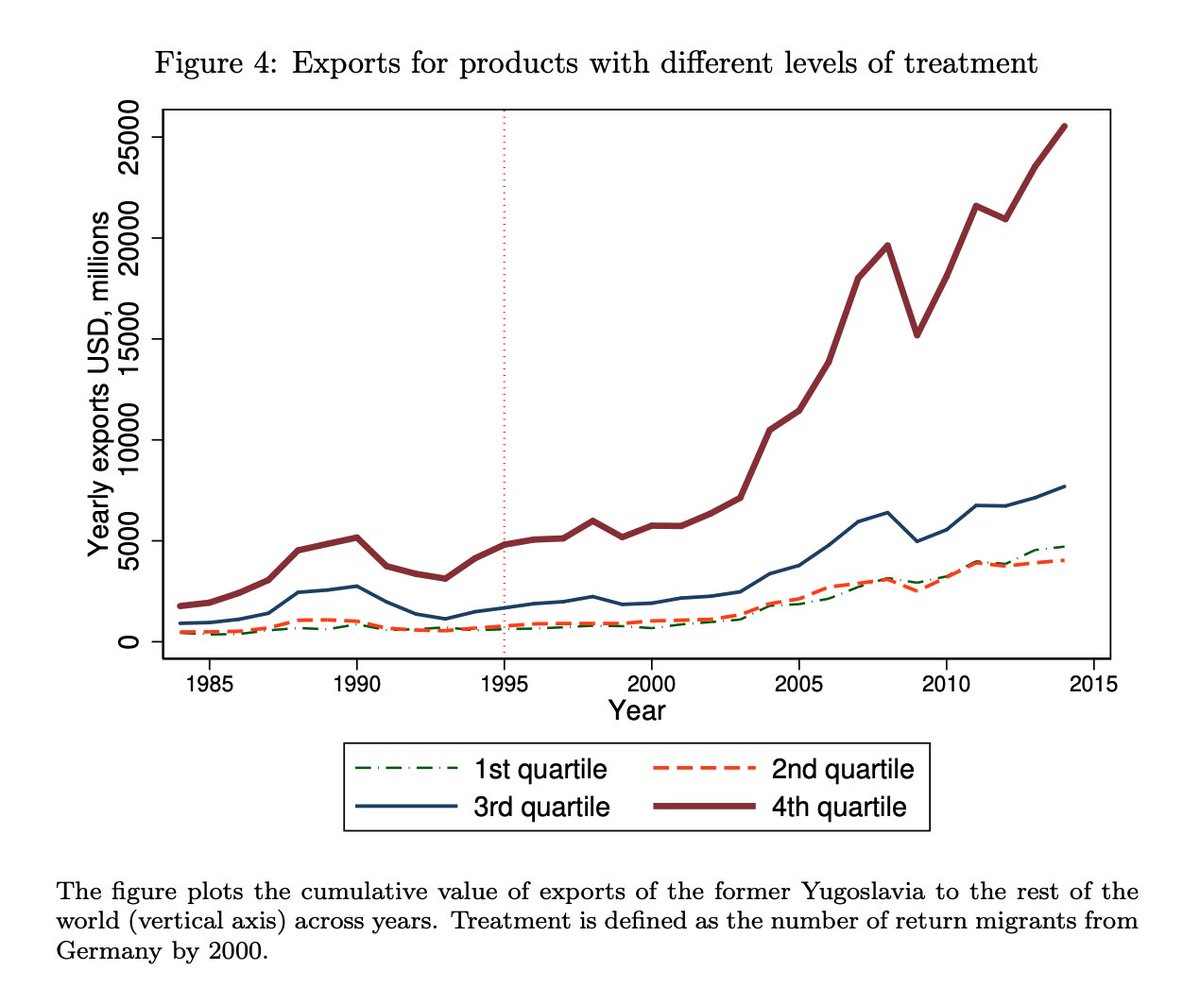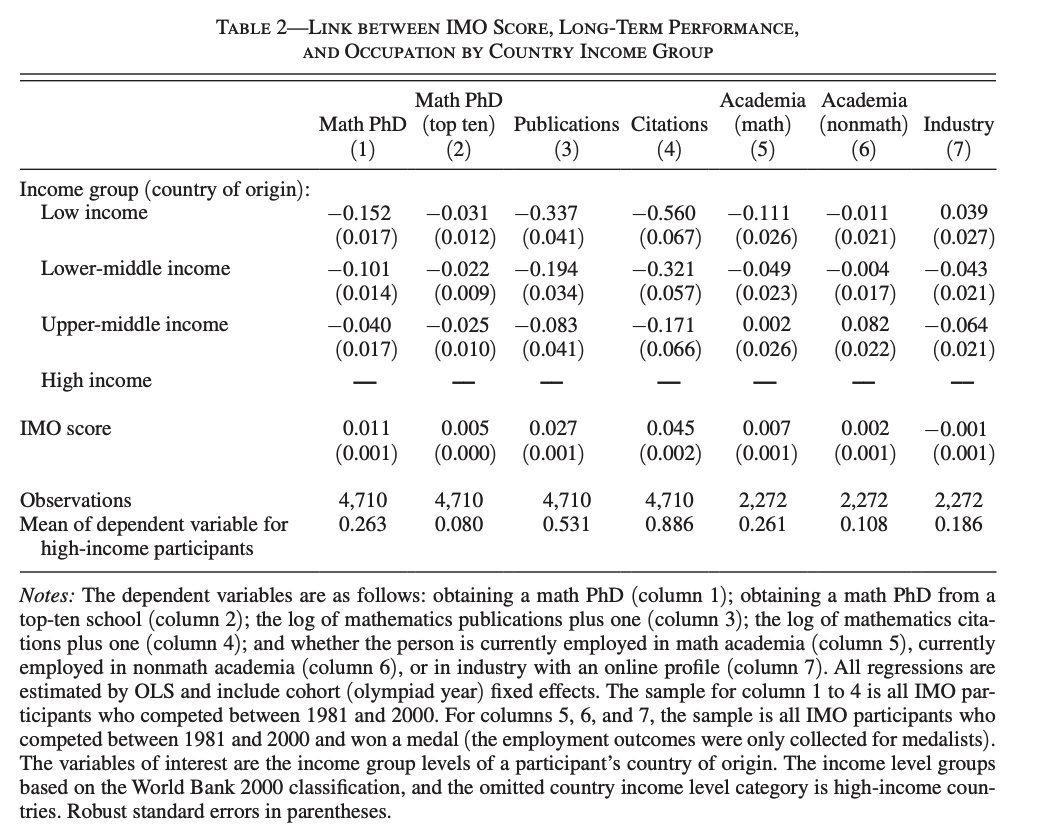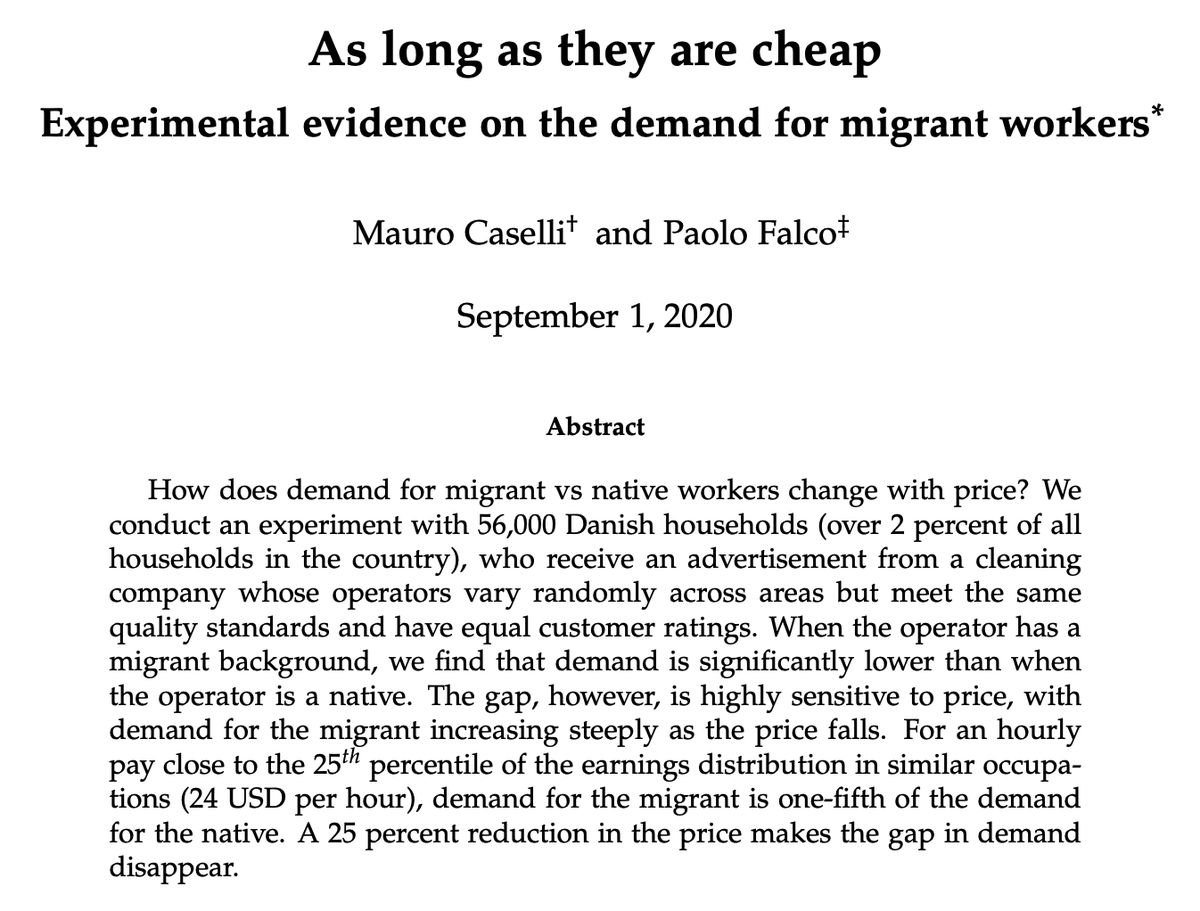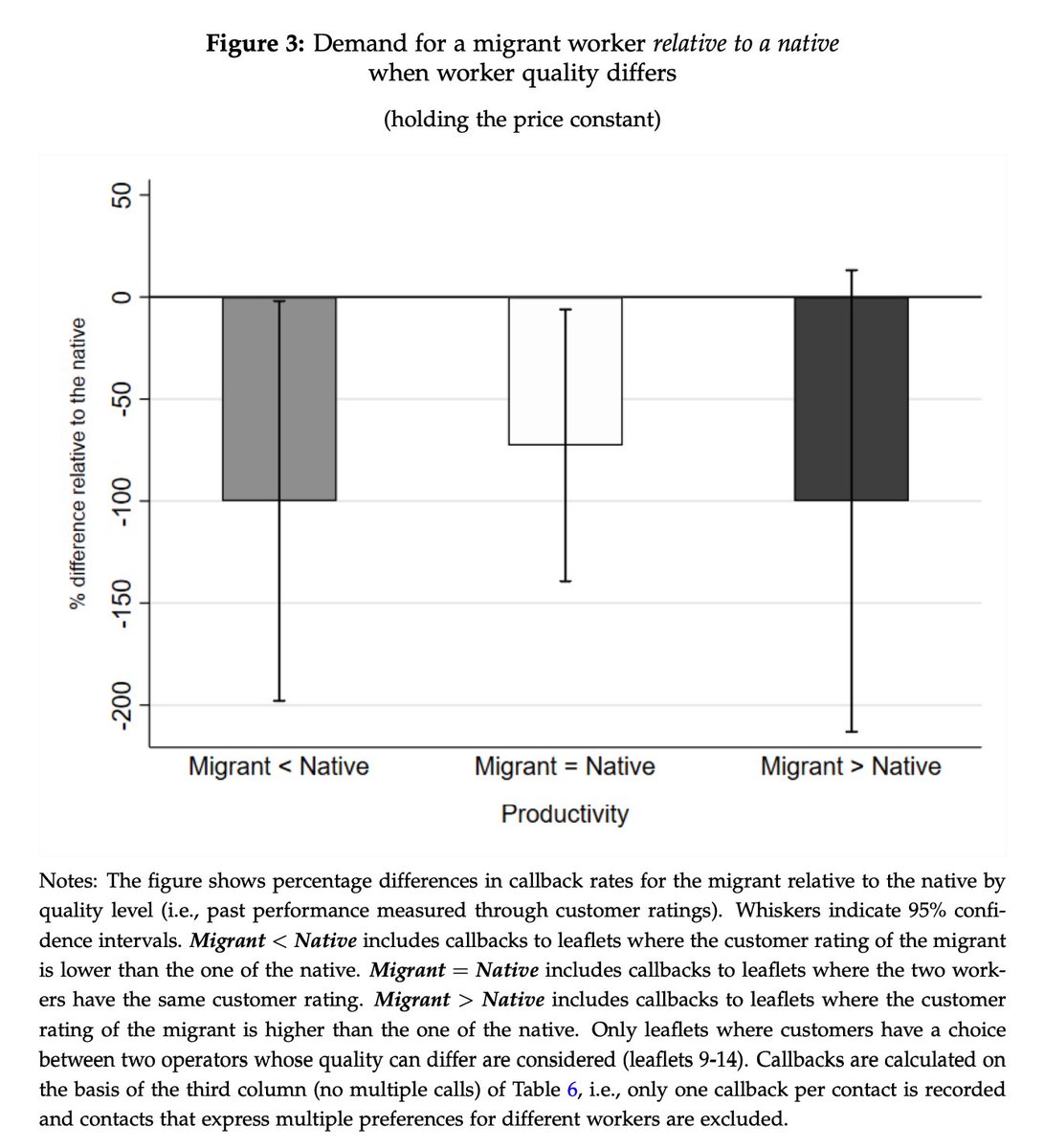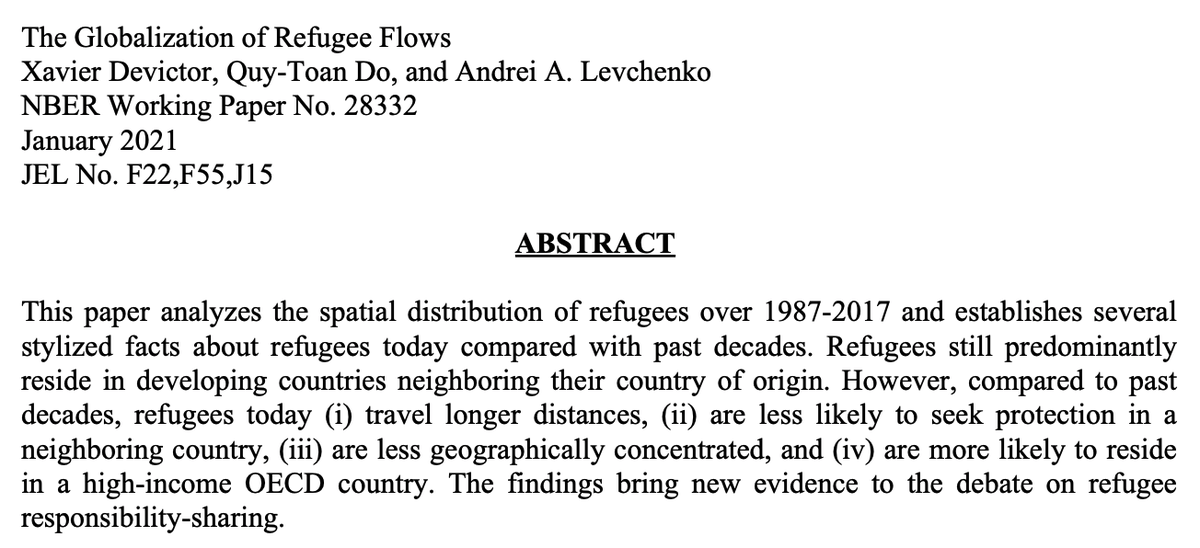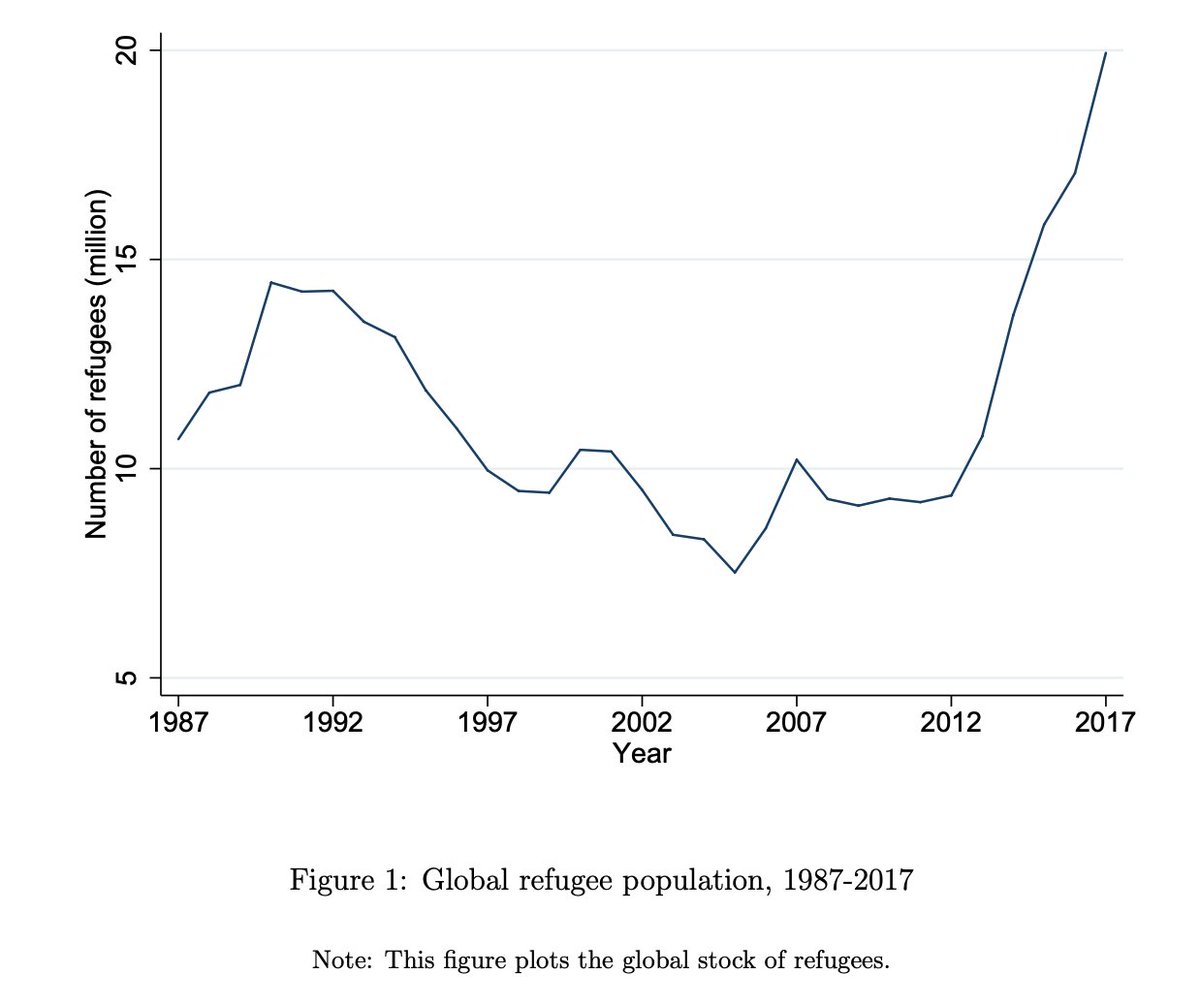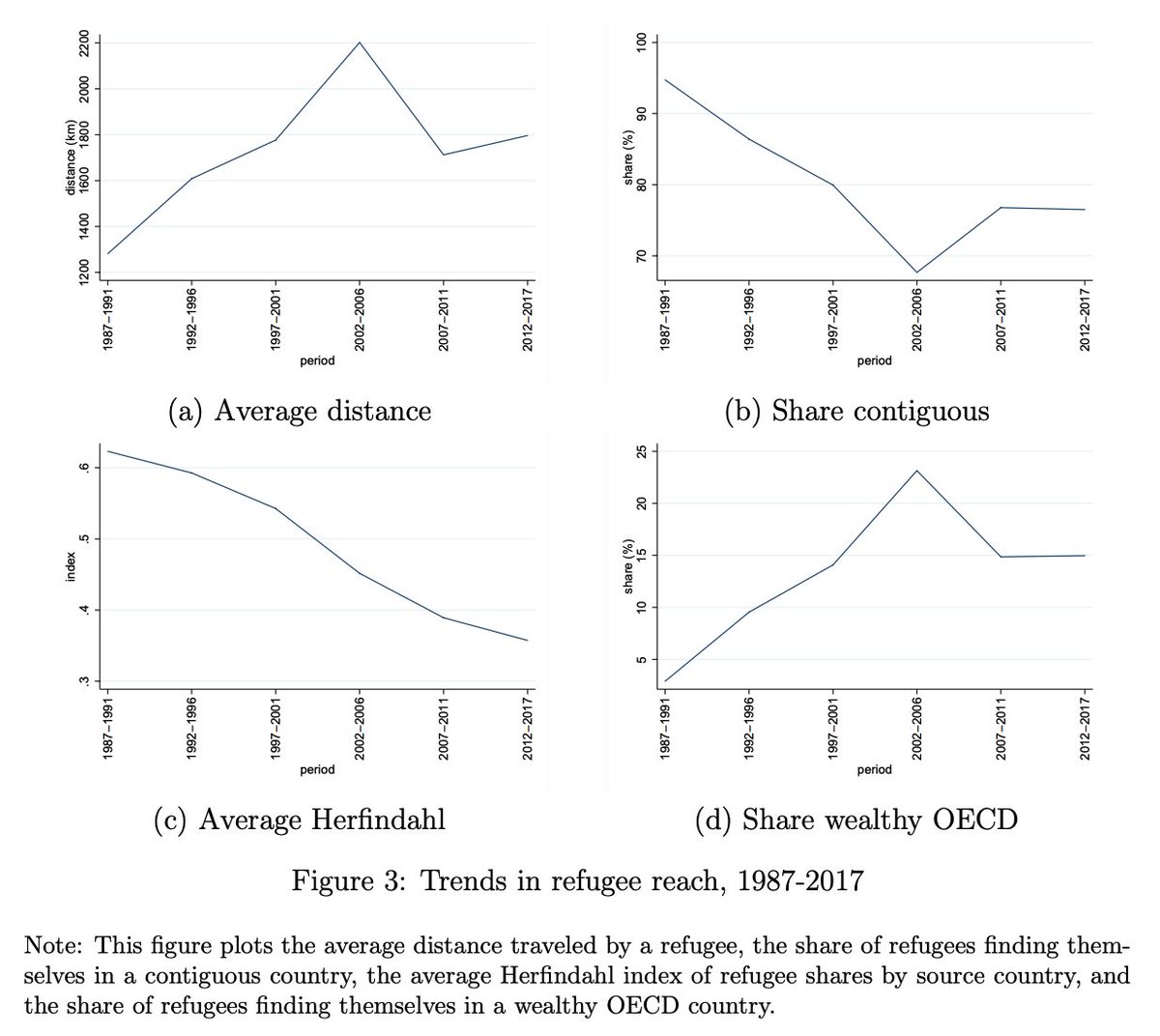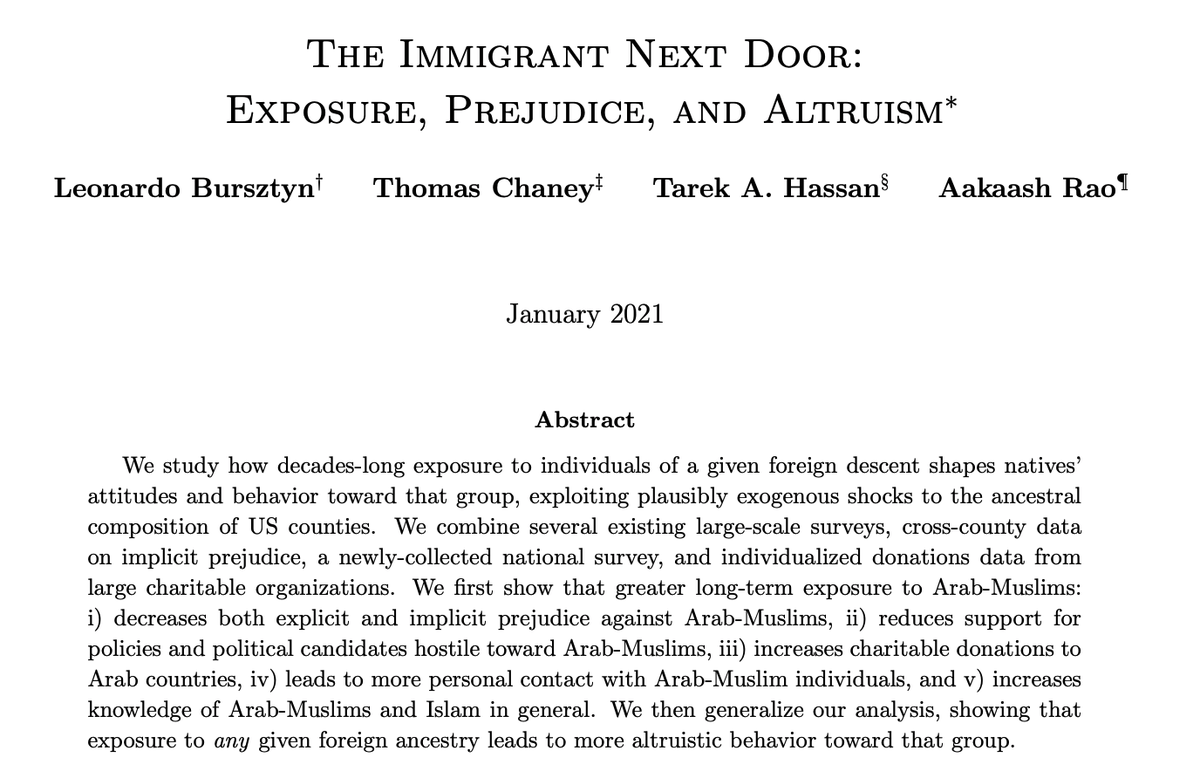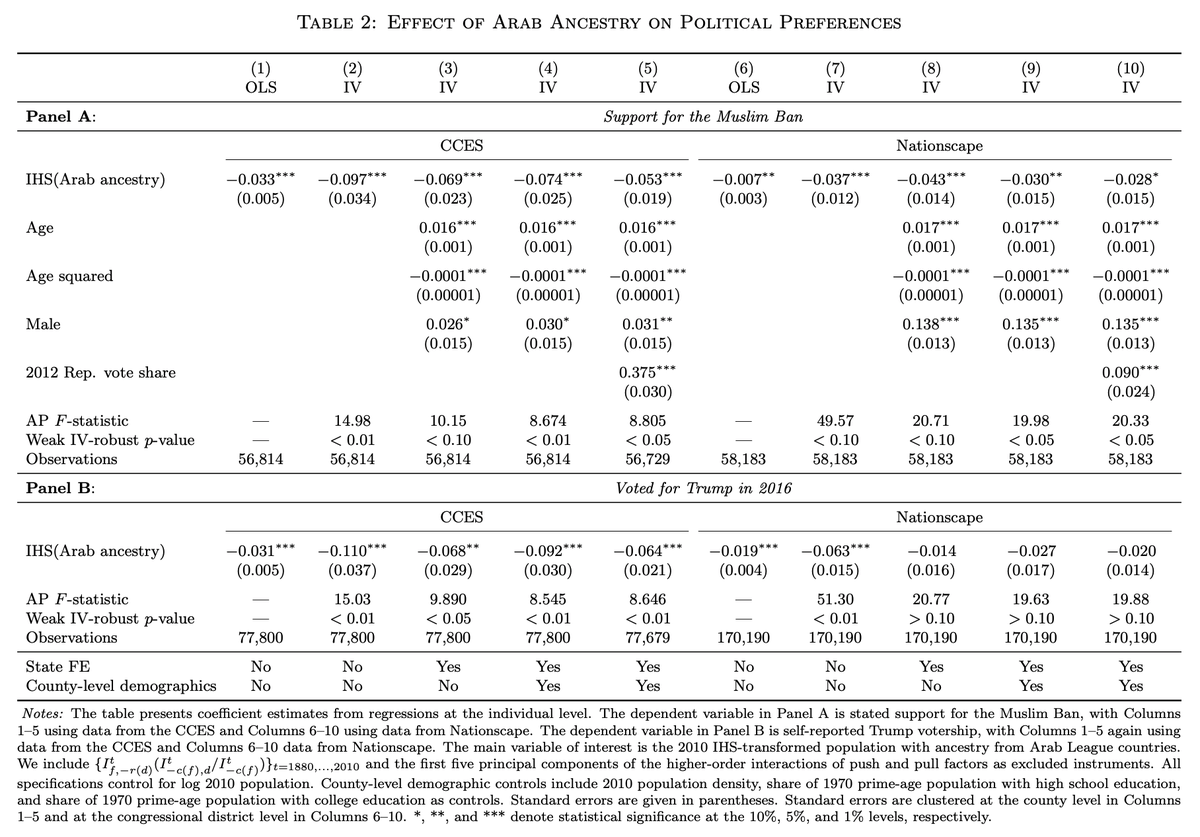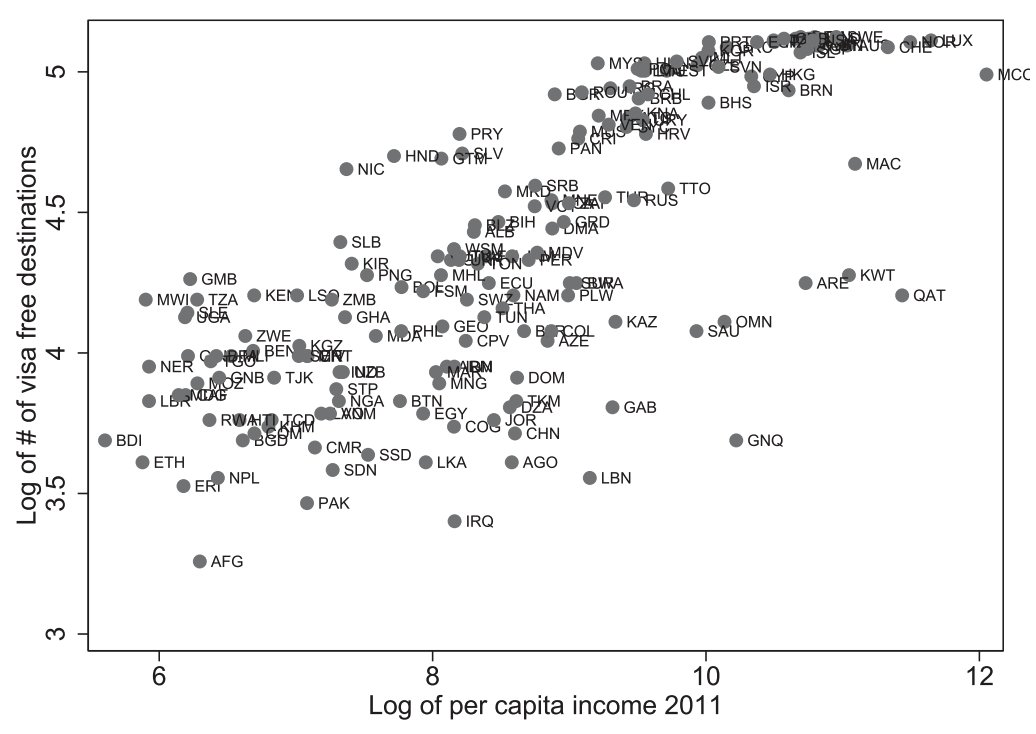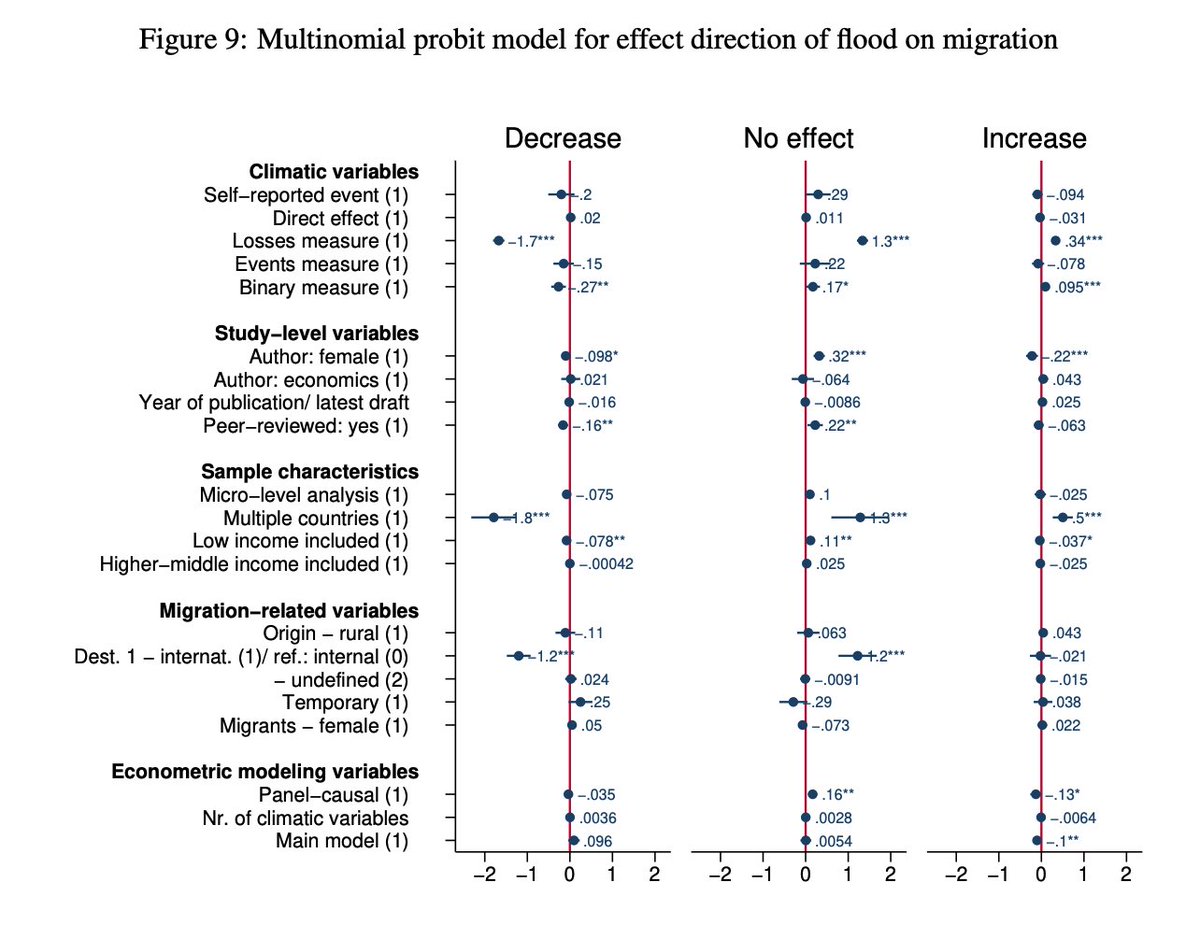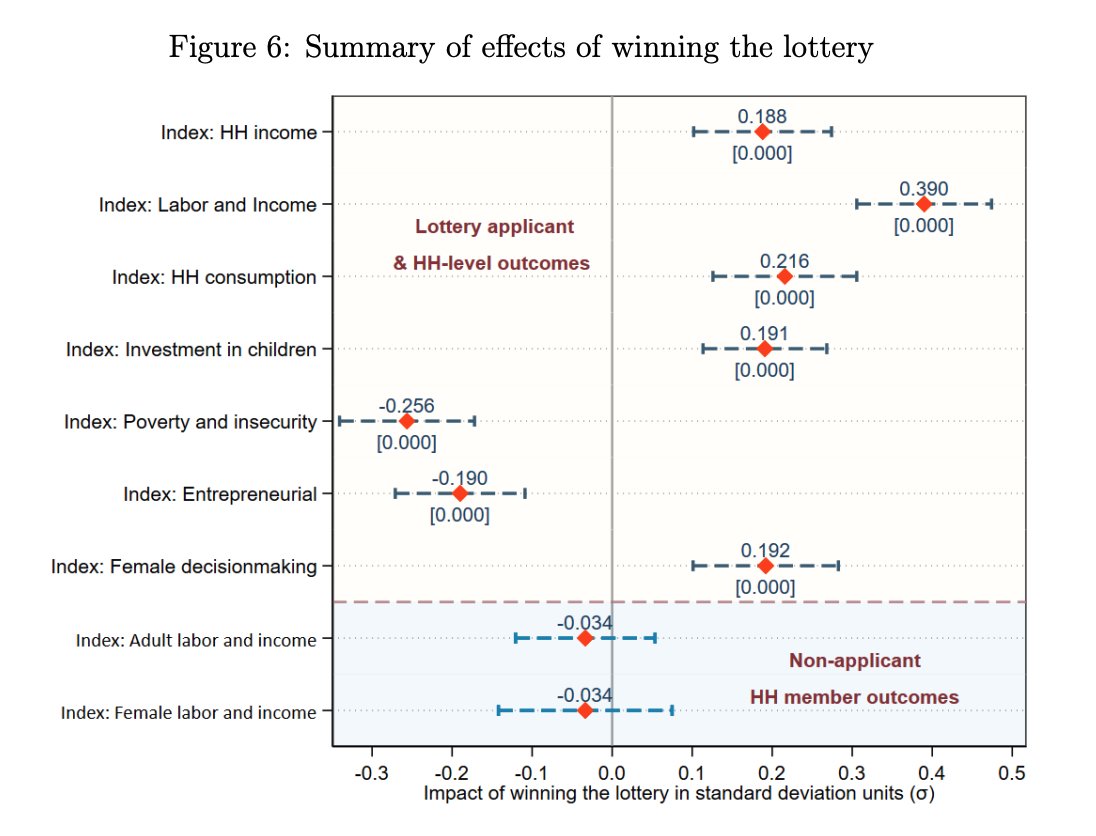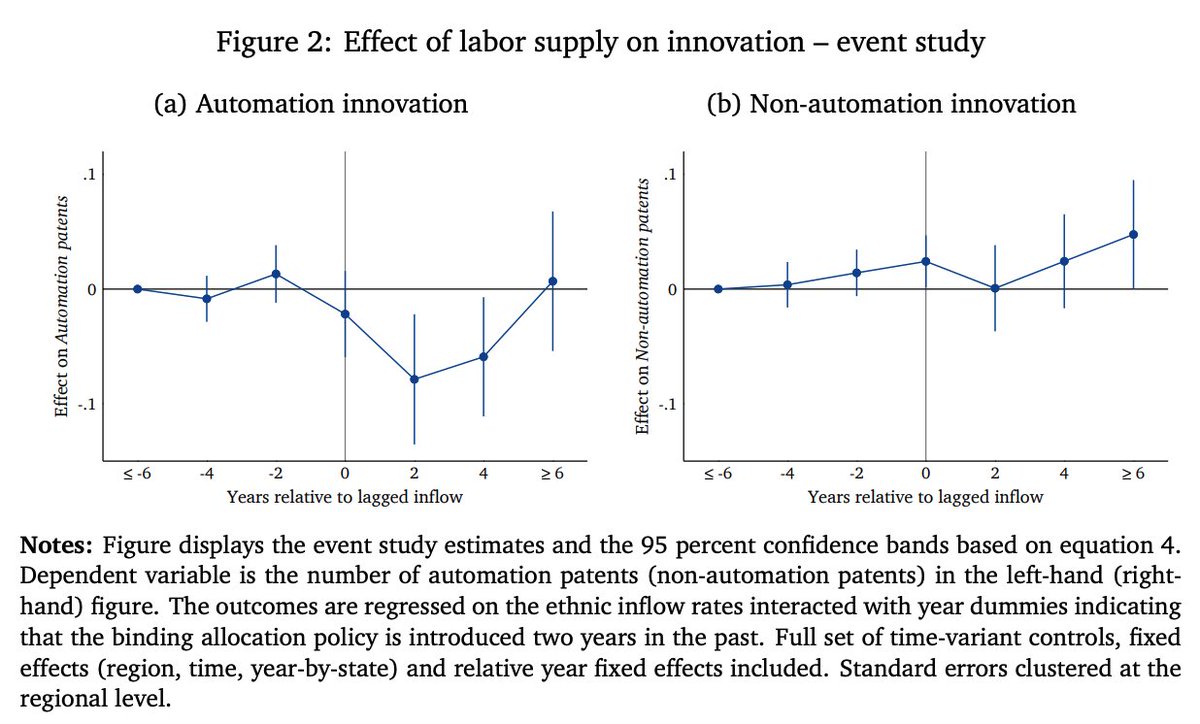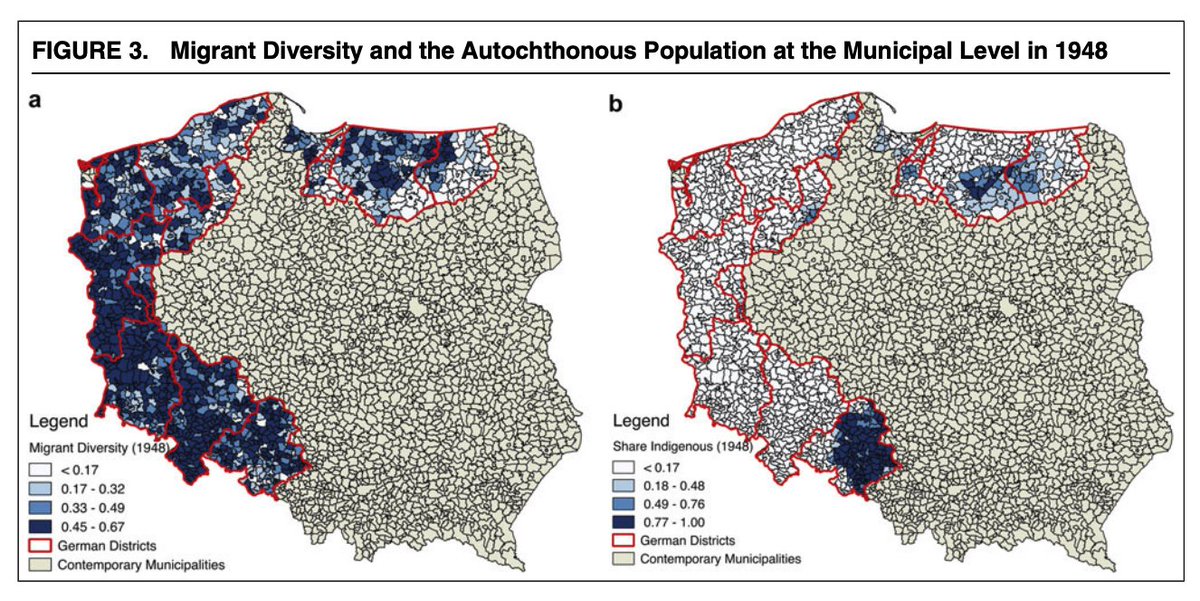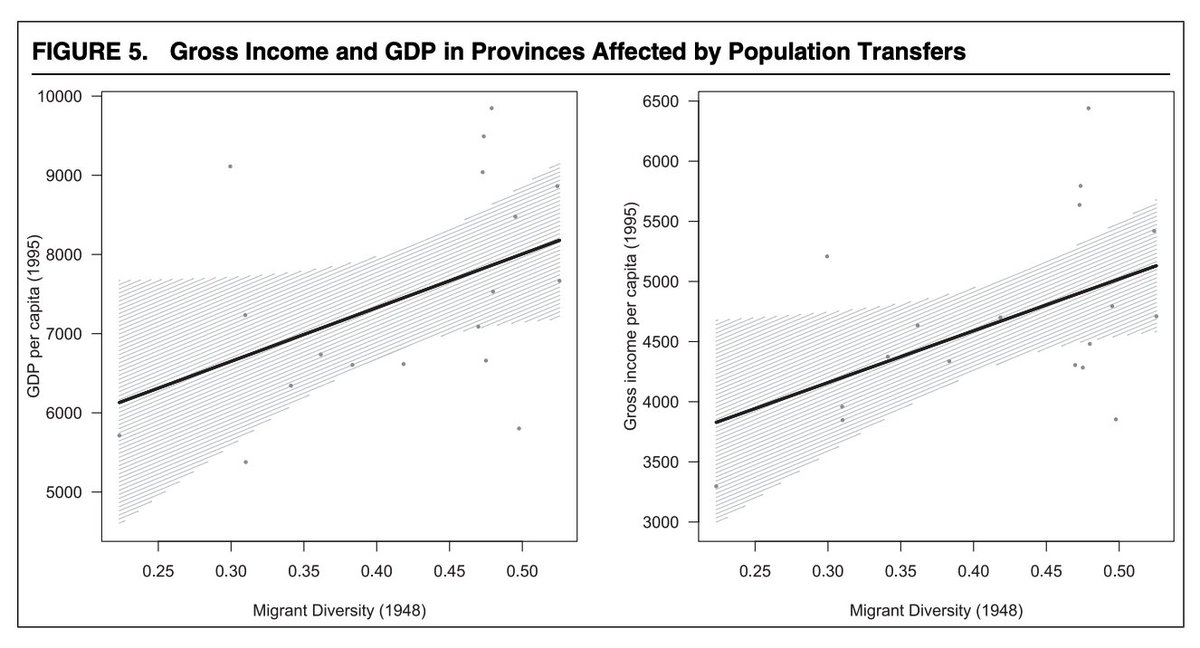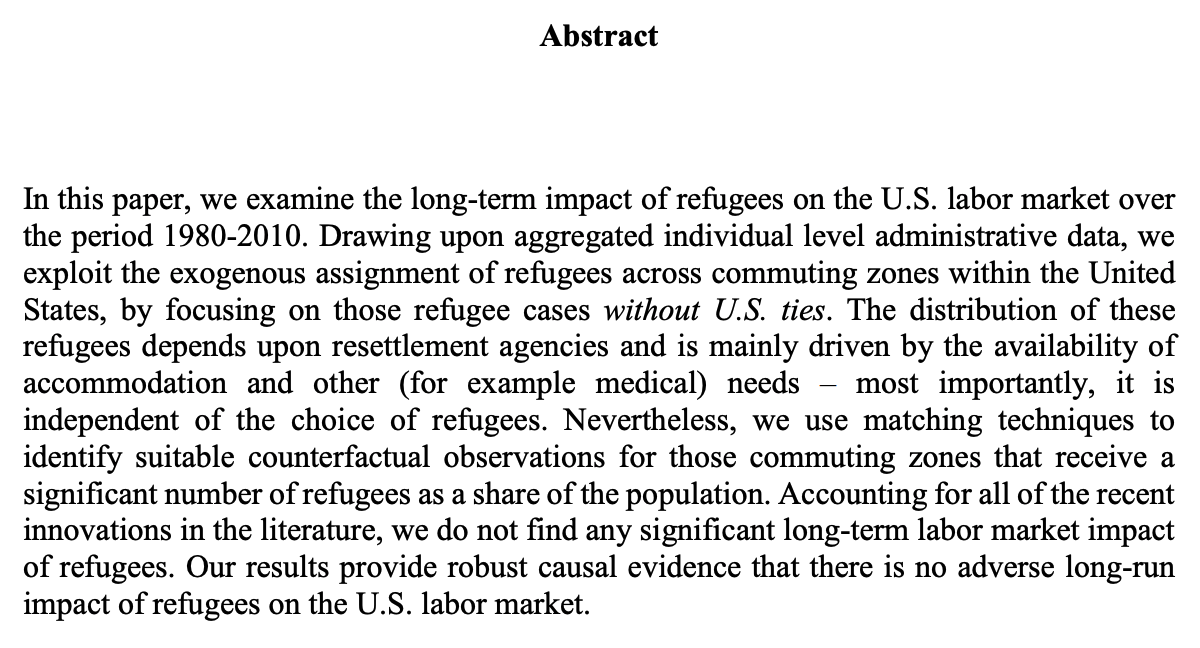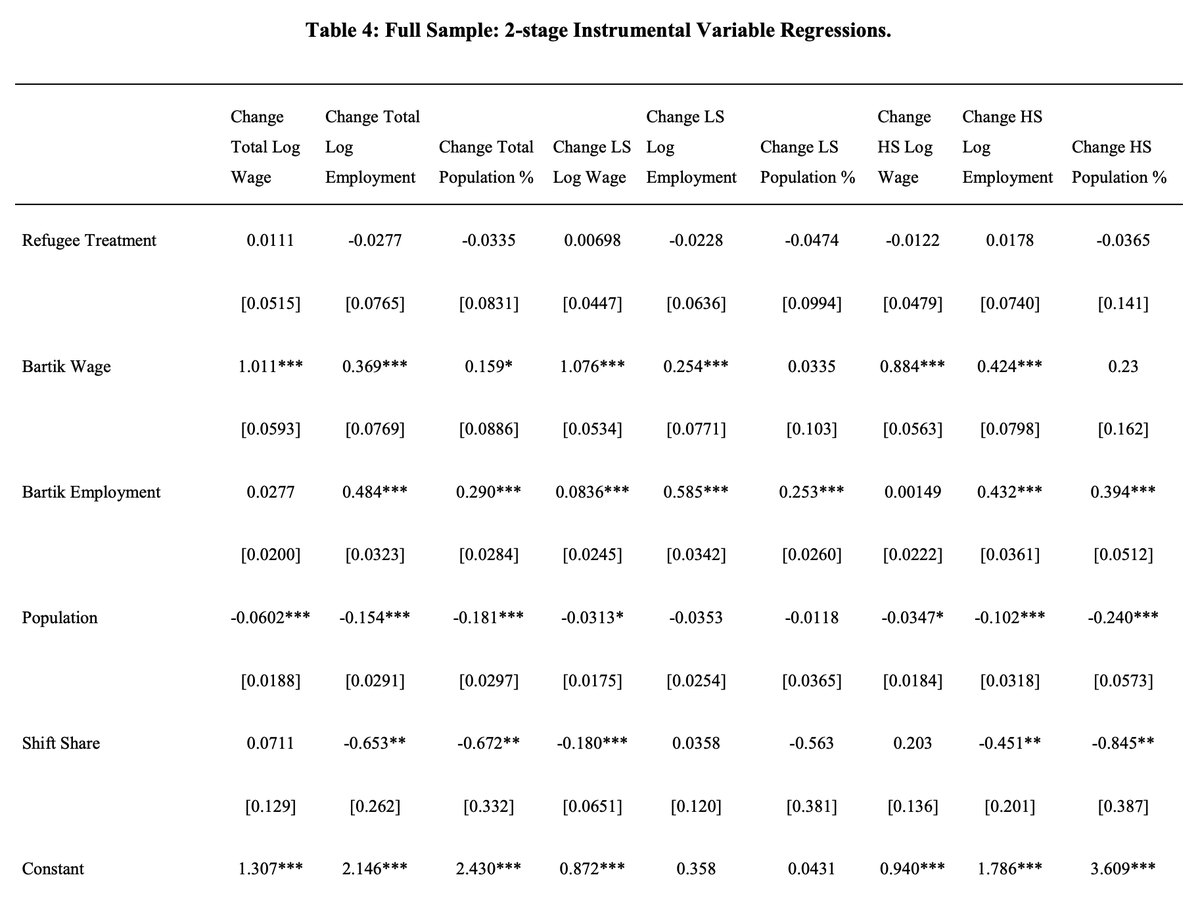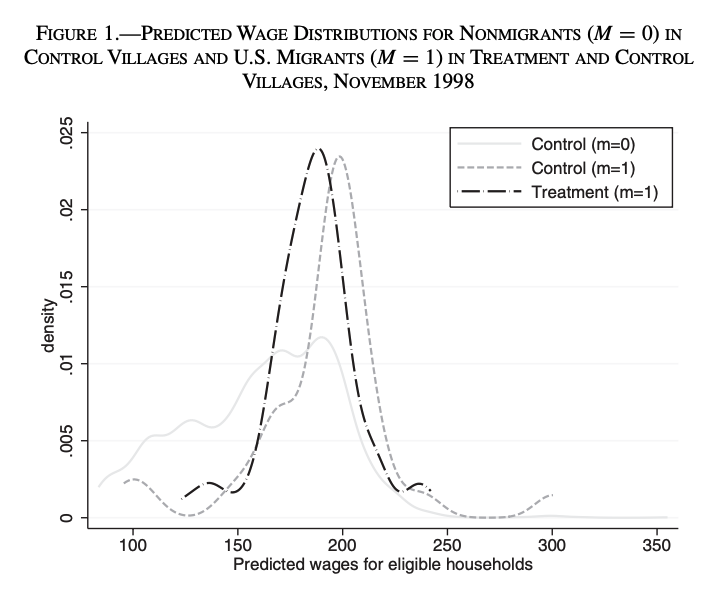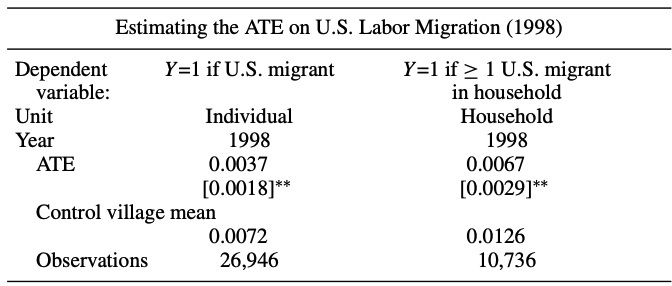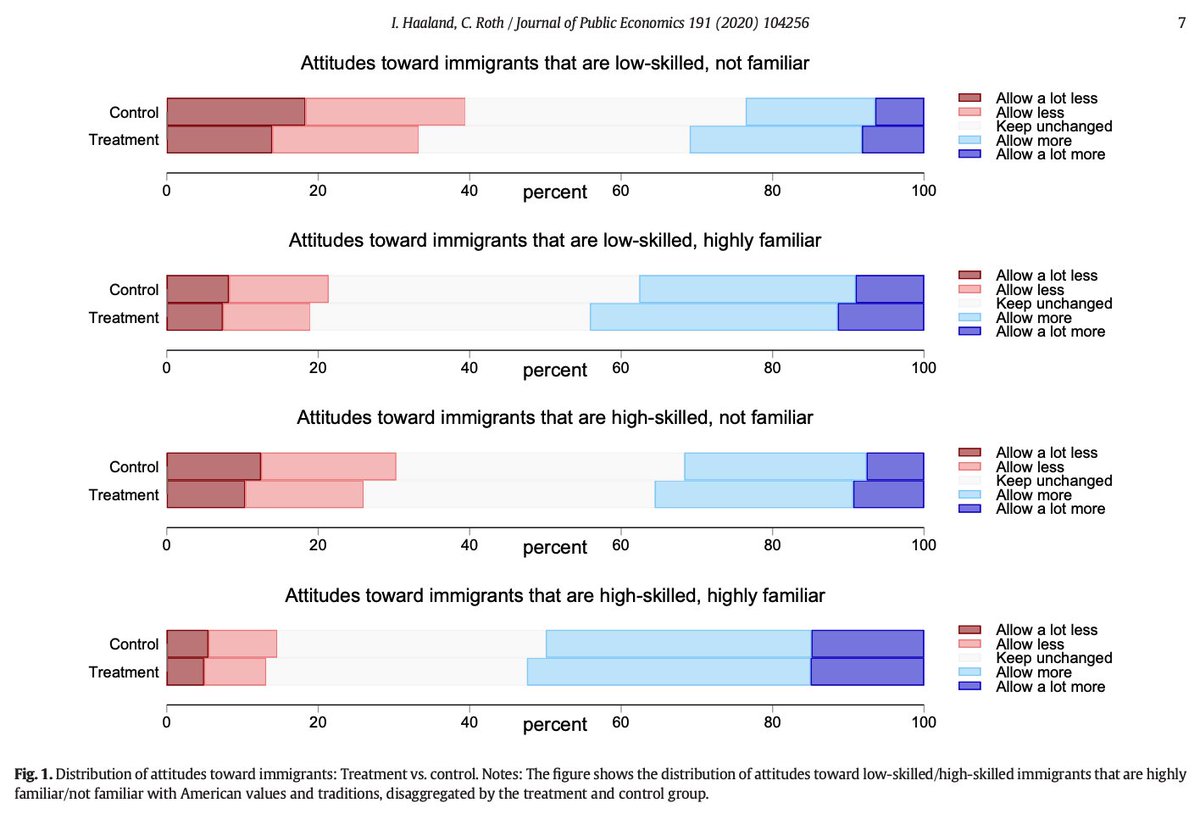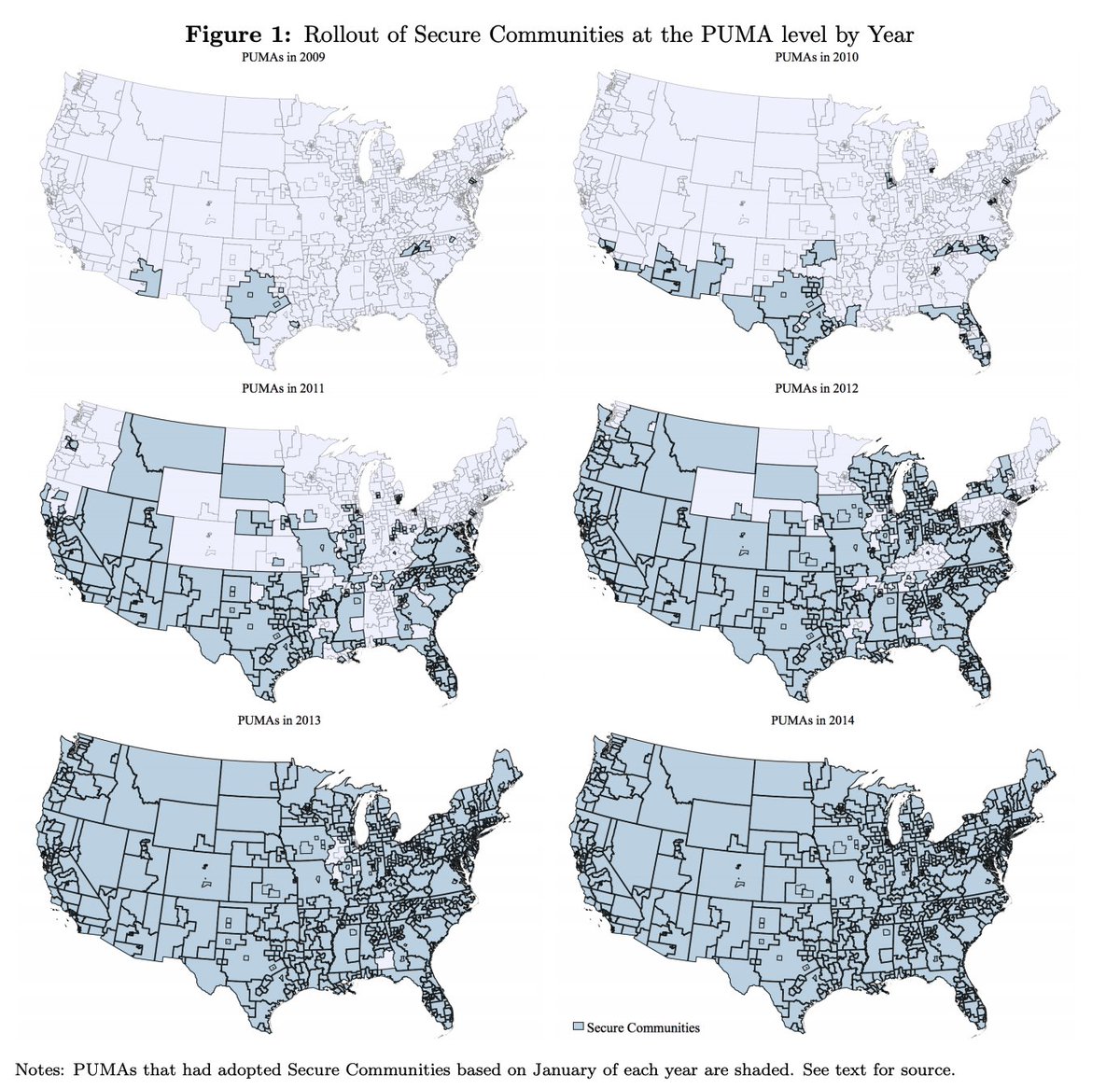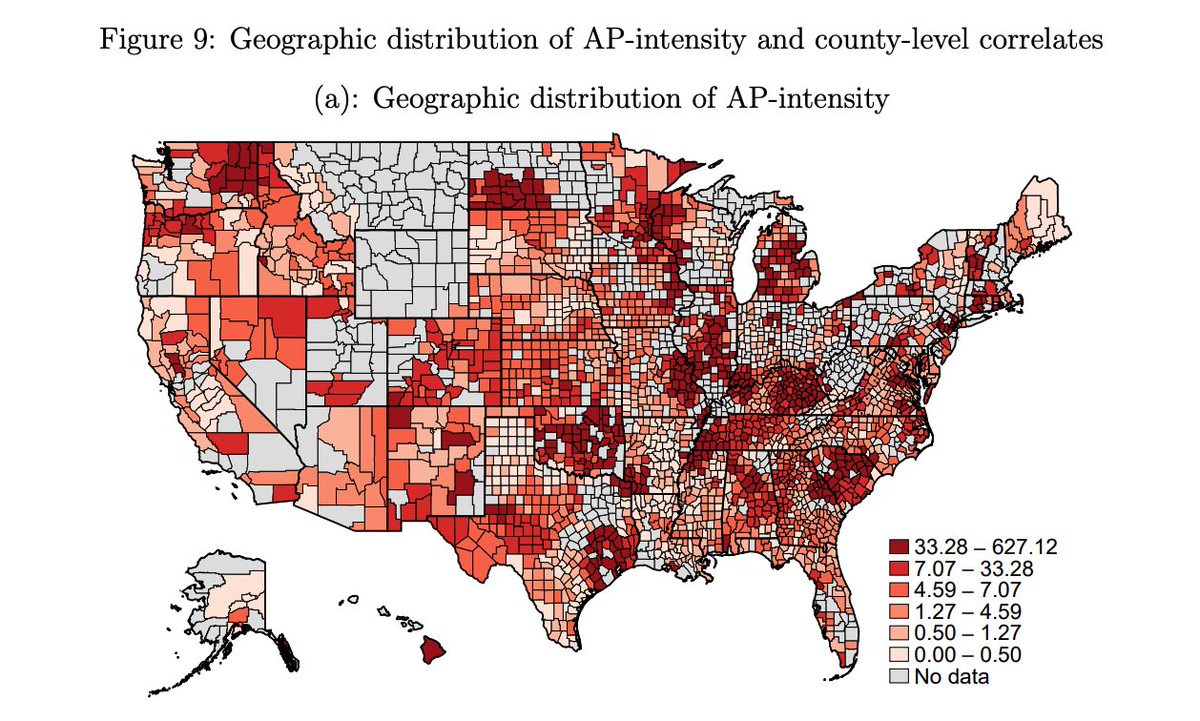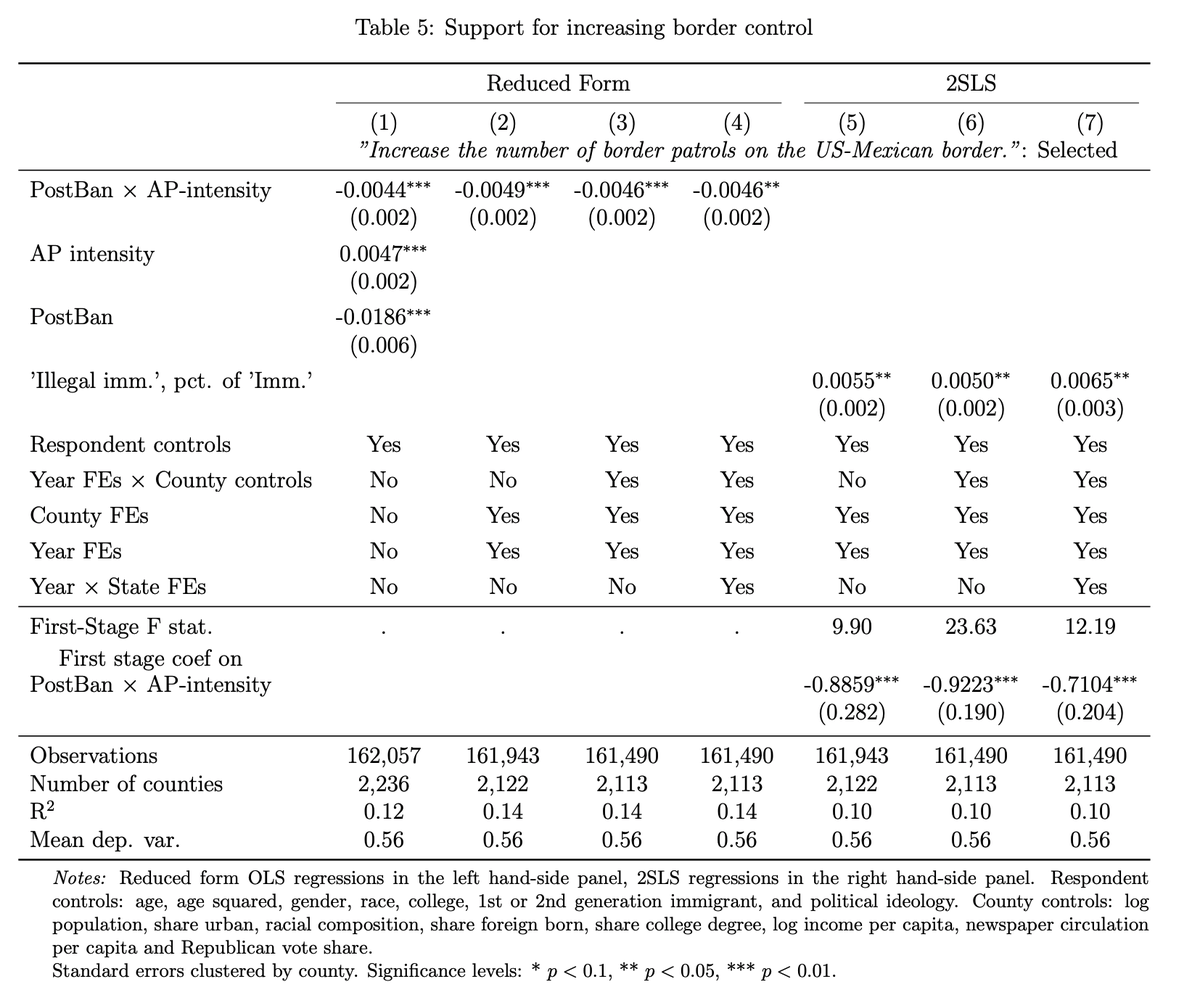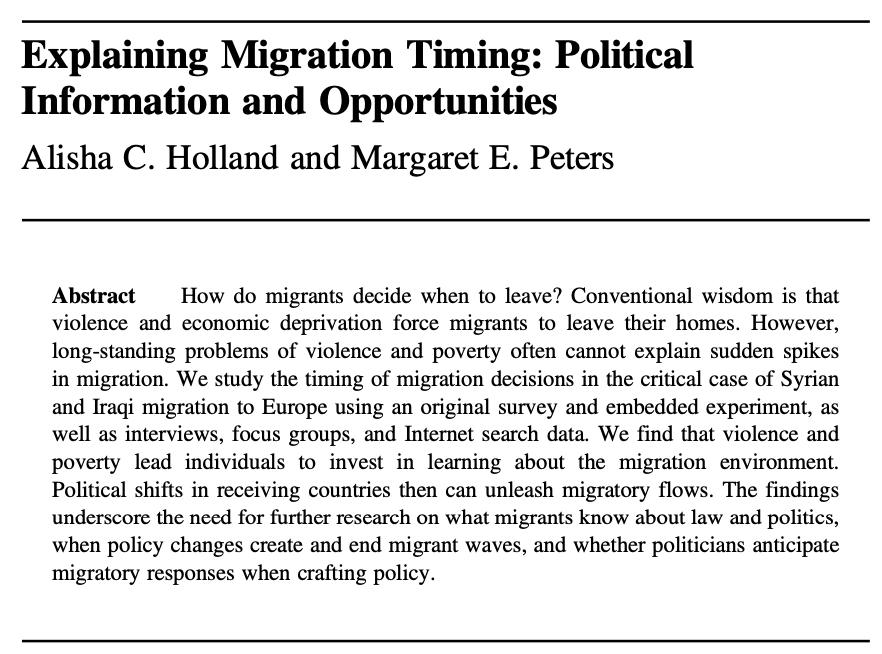A thread of remarkable research on the economics of international migration that I& #39;ve discovered recently.
I& #39;ll add to this regularly in the days ahead, in no particular order. I& #39;m summarizing frontier findings, not presenting unquestionable truths.
Pour a https://abs.twimg.com/emoji/v2/... draggable="false" alt="☕" title="Heißgetränk" aria-label="Emoji: Heißgetränk"> and join me—>
https://abs.twimg.com/emoji/v2/... draggable="false" alt="☕" title="Heißgetränk" aria-label="Emoji: Heißgetränk"> and join me—>
I& #39;ll add to this regularly in the days ahead, in no particular order. I& #39;m summarizing frontier findings, not presenting unquestionable truths.
Pour a
Pick one random US immigrant who hasn& #39;t finished high school. Pick another who has a bachelor& #39;s degree+.
The chance is 25% that the one with much less education earns more! (For natives this is 14%.)
By Bertoli ( @cerdi) and Stillman ( @unibz_news)—> https://doi.org/10.1016/j.labeco.2019.101749">https://doi.org/10.1016/j...
The chance is 25% that the one with much less education earns more! (For natives this is 14%.)
By Bertoli ( @cerdi) and Stillman ( @unibz_news)—> https://doi.org/10.1016/j.labeco.2019.101749">https://doi.org/10.1016/j...
US immigrants start businesses at a rate 80% higher than natives.
They do not just start many small firms, they start more firms of *every* size.
By @pierre_azoulay @bfjo @jdanielkim & Miranda—> https://www.nber.org/papers/w27778 ">https://www.nber.org/papers/w2... | Ungated: https://www.kellogg.northwestern.edu/faculty/jones-ben/htm/Immigration_and_Entrepreneurship_in_the_United_States.pdf">https://www.kellogg.northwestern.edu/faculty/j...
They do not just start many small firms, they start more firms of *every* size.
By @pierre_azoulay @bfjo @jdanielkim & Miranda—> https://www.nber.org/papers/w27778 ">https://www.nber.org/papers/w2... | Ungated: https://www.kellogg.northwestern.edu/faculty/jones-ben/htm/Immigration_and_Entrepreneurship_in_the_United_States.pdf">https://www.kellogg.northwestern.edu/faculty/j...
Salvadorans living under gang control have less education and income than people living only
50m away, outside of gang territory…
…not due to exposure to violence, but restrictions on labor mobility.
By @melnikov_n_v @cschmidtpadilla @micasviatschi —> http://www.micaelasviatschi.com/wp-content/uploads/2020/09/gangs_mobility_development-sep-3-2020.pdf">https://www.micaelasviatschi.com/wp-conten...
50m away, outside of gang territory…
…not due to exposure to violence, but restrictions on labor mobility.
By @melnikov_n_v @cschmidtpadilla @micasviatschi —> http://www.micaelasviatschi.com/wp-content/uploads/2020/09/gangs_mobility_development-sep-3-2020.pdf">https://www.micaelasviatschi.com/wp-conten...
I& #39;ll add more in coming days as time allows.
US immigrants receive welfare at rates much lower than natives of similar age, ethnicity, and education.
By Huang, Kaushal ( @ColumbiaSSW), & Wang ( @China_Columbia)—> https://doi.org/10.1007/s11113-020-09621-8">https://doi.org/10.1007/s...
This evidence is inconsistent with welfare being an important motivator to immigrate.
By Huang, Kaushal ( @ColumbiaSSW), & Wang ( @China_Columbia)—> https://doi.org/10.1007/s11113-020-09621-8">https://doi.org/10.1007/s...
This evidence is inconsistent with welfare being an important motivator to immigrate.
More migrants from an origin country to a destination make the countries more similar on cultural values like gender equality.
The origin becomes more like the destination, not vice versa.
By Rapoport, Sardoschau, and @politiconomics, @CESifoGroup —> https://www.cesifo.org/en/publikationen/2020/working-paper/migration-and-cultural-change">https://www.cesifo.org/en/publik...
The origin becomes more like the destination, not vice versa.
By Rapoport, Sardoschau, and @politiconomics, @CESifoGroup —> https://www.cesifo.org/en/publikationen/2020/working-paper/migration-and-cultural-change">https://www.cesifo.org/en/publik...
In 1997, parts of the Philippines suddenly got more remittances due to exchange-rate shocks.
10yrs later their incomes were still much higher, mostly due to more domestic income (!): new business, more schooling.
By @econgaurav @ctheoharides @deanyang —> https://www.amherst.edu/system/files/khanna-theoharides-yang-Nov2020-abundance-from-abroad.pdf">https://www.amherst.edu/system/fi...
10yrs later their incomes were still much higher, mostly due to more domestic income (!): new business, more schooling.
By @econgaurav @ctheoharides @deanyang —> https://www.amherst.edu/system/files/khanna-theoharides-yang-Nov2020-abundance-from-abroad.pdf">https://www.amherst.edu/system/fi...
Among male US immigrants in 1880, occupational income varied by ethnicity.
That explains more than ½ of ethnic gaps in occupational income among *their grandsons* in 1940.
By @EconZach —> https://doi.org/10.1257/app.20170382
Before">https://doi.org/10.1257/a... comparing present to past, we must understand the past.
That explains more than ½ of ethnic gaps in occupational income among *their grandsons* in 1940.
By @EconZach —> https://doi.org/10.1257/app.20170382
Before">https://doi.org/10.1257/a... comparing present to past, we must understand the past.
Rural Kenyans underestimate how much they could earn in cities…
…in part because prior migrants—wary of requests for money—tell folks back home their earnings are low.
Giving people accurate information raises migration 39%.
By Travis Baseler @UofR —> https://sites.google.com/view/travisbaseler/research">https://sites.google.com/view/trav...
…in part because prior migrants—wary of requests for money—tell folks back home their earnings are low.
Giving people accurate information raises migration 39%.
By Travis Baseler @UofR —> https://sites.google.com/view/travisbaseler/research">https://sites.google.com/view/trav...
Denmark settled refugees around the country quasi-randomly in the 1990s.
In places that received the fewest migrants, firms became relatively more likely to offshore production—a decade later.
By Olney & Pozzoli in @restatjournal —> https://doi.org/10.1162/rest_a_00861">https://doi.org/10.1162/r...
In places that received the fewest migrants, firms became relatively more likely to offshore production—a decade later.
By Olney & Pozzoli in @restatjournal —> https://doi.org/10.1162/rest_a_00861">https://doi.org/10.1162/r...
China places fewer restrictions on migration by more educated workers. They tend to leave polluted cities.
This skewed distribution of skill reduces GDP—almost as much as the health harms of pollution.
By @econgaurav @WenquanLiang @mushfiq_econ & Song—> https://ssrn.com/abstract=3776971">https://ssrn.com/abstract=...
This skewed distribution of skill reduces GDP—almost as much as the health harms of pollution.
By @econgaurav @WenquanLiang @mushfiq_econ & Song—> https://ssrn.com/abstract=3776971">https://ssrn.com/abstract=...
Among US men age 18–40, unauthorized immigrants are 33% less likely to be incarcerated than natives.
Inflows of unauthorized immigrants have no statistically precise effect on rates of violent crime or property crime.
By Christian Gunadi @UCSanDiego —> https://doi.org/10.1093/oep/gpz057">https://doi.org/10.1093/o...
Inflows of unauthorized immigrants have no statistically precise effect on rates of violent crime or property crime.
By Christian Gunadi @UCSanDiego —> https://doi.org/10.1093/oep/gpz057">https://doi.org/10.1093/o...
When high-skill emigration rises from a European country, firms in that industry lose productivity.
The negative effect lasts two years, and reverses by year five—even as emigration continues.
By Giesing ( @ifo_Institut) & Laurentsyeva ( @LMU_Muenchen)—> https://www.dropbox.com/s/g93icznuj4tq6fe/Firms_Left_Behind__Emigration_and_Firm_Productivity.pdf?dl=0">https://www.dropbox.com/s/g93iczn...
The negative effect lasts two years, and reverses by year five—even as emigration continues.
By Giesing ( @ifo_Institut) & Laurentsyeva ( @LMU_Muenchen)—> https://www.dropbox.com/s/g93icznuj4tq6fe/Firms_Left_Behind__Emigration_and_Firm_Productivity.pdf?dl=0">https://www.dropbox.com/s/g93iczn...
100s of thousands of refugees fled former Yugoslavia to Germany in the 1990s, then returned home.
Production+exports took off there—in the industries where they& #39;d worked abroad. Ideas came home with them.
By @dany_bahar @CemOzguzel Hauptmann & Rapoport—> https://www.iza.org/en/publications/dp/12412">https://www.iza.org/en/public...
Production+exports took off there—in the industries where they& #39;d worked abroad. Ideas came home with them.
By @dany_bahar @CemOzguzel Hauptmann & Rapoport—> https://www.iza.org/en/publications/dp/12412">https://www.iza.org/en/public...
Kids equally talented in math (by scores in the International Mathematical Olympiad) are 15% less likely to get a math PhD, and their research gets 56% fewer citations…
…if they are born in a low-income country.
By @_RuchirAgarwal & @patrick_gaule —> https://doi.org/10.1257/aeri.20190457">https://doi.org/10.1257/a...
…if they are born in a low-income country.
By @_RuchirAgarwal & @patrick_gaule —> https://doi.org/10.1257/aeri.20190457">https://doi.org/10.1257/a...
Why do immigrants often earn less than natives? A remarkable randomized experiment in Denmark:
For workers of the same productivity (by client ratings of service quality), natives were willing to pay 25% less for an immigrant.
By Caselli & @paofal —> https://dagliano.unimi.it/wp-content/uploads/2020/09/WP466.pdf">https://dagliano.unimi.it/wp-conten...
For workers of the same productivity (by client ratings of service quality), natives were willing to pay 25% less for an immigrant.
By Caselli & @paofal —> https://dagliano.unimi.it/wp-content/uploads/2020/09/WP466.pdf">https://dagliano.unimi.it/wp-conten...
Relative to 25 years ago, refugees today:
—Are more numerous
—Live farther from home
—Are less likely to live in neighboring countries
—Are more likely to live in OECD countries
By Devictor, Do, and Levchenko—> http://www.nber.org/papers/w28332 ">https://www.nber.org/papers/w2... | Earlier ungated: http://hdl.handle.net/10986/33580 ">https://hdl.handle.net/10986/335...
—Are more numerous
—Live farther from home
—Are less likely to live in neighboring countries
—Are more likely to live in OECD countries
By Devictor, Do, and Levchenko—> http://www.nber.org/papers/w28332 ">https://www.nber.org/papers/w2... | Earlier ungated: http://hdl.handle.net/10986/33580 ">https://hdl.handle.net/10986/335...
Historical shocks to migrant settlement shape the extent of Americans& #39; contact, today, with Arab Muslims in daily life.
This contact by itself reduces attitudes and voting hostile to Arab-Muslims.
By Bursztyn, @thomas_chaney, Hassan, & @aakaash_rao —> https://bfi.uchicago.edu/working-paper/2021-16/">https://bfi.uchicago.edu/working-p...
This contact by itself reduces attitudes and voting hostile to Arab-Muslims.
By Bursztyn, @thomas_chaney, Hassan, & @aakaash_rao —> https://bfi.uchicago.edu/working-paper/2021-16/">https://bfi.uchicago.edu/working-p...
When other countries impose travel visa requirements on African countries, this severely curtails trade between them.
For some African countries, the visa requirement reduces welfare >5% by the mechanism of reduced trade alone.
By @CamiloUmanaD —> https://doi.org/10.1016/j.jdeveco.2019.05.002">https://doi.org/10.1016/j...
For some African countries, the visa requirement reduces welfare >5% by the mechanism of reduced trade alone.
By @CamiloUmanaD —> https://doi.org/10.1016/j.jdeveco.2019.05.002">https://doi.org/10.1016/j...
Immigrant inventors account for 30% of all US patenting since 1976—mostly via indirect spillovers on natives& #39; innovation.
A remarkable research design exploiting premature deaths of inventors.
By Bernstein, @rebeccardiamond, McQuade, @bibipousada —> https://www.gsb.stanford.edu/faculty-research/working-papers/contribution-high-skilled-immigrants-innovation-united-states">https://www.gsb.stanford.edu/faculty-r...
A remarkable research design exploiting premature deaths of inventors.
By Bernstein, @rebeccardiamond, McQuade, @bibipousada —> https://www.gsb.stanford.edu/faculty-research/working-papers/contribution-high-skilled-immigrants-innovation-united-states">https://www.gsb.stanford.edu/faculty-r...
The literature so far finds climate migration mostly in middle-income countries, internally from rural areas to cities.
This & many other insights in a meta-analysis of the literature on climate migration by @Barbora_Sedova, Čizmaziová, and Cook—> https://doi.org/10.25932/publishup-49982">https://doi.org/10.25932/...
This & many other insights in a meta-analysis of the literature on climate migration by @Barbora_Sedova, Čizmaziová, and Cook—> https://doi.org/10.25932/publishup-49982">https://doi.org/10.25932/...
Otherwise identical Bangladeshi workers (picked by lottery) triple their earnings in Malaysia.
These visas "rank among the most successful anti-poverty and development interventions for rural
Bangladesh"
by @mushfiq_econ @iffath_sharif & Shrestha—> https://www.iza.org/publications/dp/14232">https://www.iza.org/publicati...
These visas "rank among the most successful anti-poverty and development interventions for rural
Bangladesh"
by @mushfiq_econ @iffath_sharif & Shrestha—> https://www.iza.org/publications/dp/14232">https://www.iza.org/publicati...
Showing young Malians films about role models with positive or negative migration experiences does not affect their intent to migrate.
The last sentence of the abstract says it all.
Remarkable experiment by @mesple_somps & @NilssonBjoern —> https://hal.archives-ouvertes.fr/hal-03105639 ">https://hal.archives-ouvertes.fr/hal-03105...
The last sentence of the abstract says it all.
Remarkable experiment by @mesple_somps & @NilssonBjoern —> https://hal.archives-ouvertes.fr/hal-03105639 ">https://hal.archives-ouvertes.fr/hal-03105...
+1 immigrant worker/1,000 manual workers in Germany reduces automation innovation by 0.05 patents.
Put differently: immigration restrictions contribute to job-reducing automation, as @ethanglewis has found.
New research by Danzer, Feuerbaum, @FGaessler—>
https://www.iza.org/publications/dp/13429">https://www.iza.org/publicati...
Put differently: immigration restrictions contribute to job-reducing automation, as @ethanglewis has found.
New research by Danzer, Feuerbaum, @FGaessler—>
https://www.iza.org/publications/dp/13429">https://www.iza.org/publicati...
Ethnic diversity created by a force majeure—post WW2 population resettlement—raised incomes 50 years later.
An important mechanism: higher demand for state capacity to produce public goods, less reliance on informal norms.
By @vcharnysh in @apsrjournal—> https://doi.org/10.1017/S0003055419000042">https://doi.org/10.1017/S...
An important mechanism: higher demand for state capacity to produce public goods, less reliance on informal norms.
By @vcharnysh in @apsrjournal—> https://doi.org/10.1017/S0003055419000042">https://doi.org/10.1017/S...
US workers in areas that welcomed the most refugees had wages and employment indistinguishable from areas that welcomed the fewest refugees, 1980–2010. Including least-educated workers.
Research by @mayda_anna @ParsonsEcon Peri and Wagner—> https://www.state.gov/wp-content/uploads/2018/12/The-Labor-Market-Impact-on-Refugees-Evidence-form-the-U.S.-Resettlement-Program-1.pdf">https://www.state.gov/wp-conten...
Research by @mayda_anna @ParsonsEcon Peri and Wagner—> https://www.state.gov/wp-content/uploads/2018/12/The-Labor-Market-Impact-on-Refugees-Evidence-form-the-U.S.-Resettlement-Program-1.pdf">https://www.state.gov/wp-conten...
Cash transfers to & #39;stop migration& #39; are a hot topic.
Cash transfers to low-income Mexican households *raised* migration to the US. They provided liquidity to invest in what is, for many, the best available investment.
By @M_Angeluc in @restatjournal —> http://doi.org/10.1162/REST_a_00487">https://doi.org/10.1162/R...
Cash transfers to low-income Mexican households *raised* migration to the US. They provided liquidity to invest in what is, for many, the best available investment.
By @M_Angeluc in @restatjournal —> http://doi.org/10.1162/REST_a_00487">https://doi.org/10.1162/R...
Research matters. Just telling people the robust results of David Card& #39;s Mariel Boatlift study—null effects on wages+employment, all skill levels—lastingly eases their opposition to immigration.
Remarkable experiment by @Ingar30 + @cp_roth in @JPubEcon —> https://doi.org/10.1016/j.jpubeco.2020.104256">https://doi.org/10.1016/j...
Remarkable experiment by @Ingar30 + @cp_roth in @JPubEcon —> https://doi.org/10.1016/j.jpubeco.2020.104256">https://doi.org/10.1016/j...
A large-scale US program to detain and deport undocumented immigrants reduced the labor supply of citizens: highly educated women.
The mechanism: reduced access to childcare and other household services.
Research by @ChloeEast2 and @a_velasquezg —> https://www.andreapvelasquez.com/uploads/1/2/2/1/122112301/draft.pdf">https://www.andreapvelasquez.com/uploads/1...
The mechanism: reduced access to childcare and other household services.
Research by @ChloeEast2 and @a_velasquezg —> https://www.andreapvelasquez.com/uploads/1/2/2/1/122112301/draft.pdf">https://www.andreapvelasquez.com/uploads/1...
The terminology used for immigrants, by itself, can shape policy preferences.
An @AssociatedPress ban on the term "illegal immigrant" caused lower support in more exposed counties for border-enforcement crackdown.
Research by @MNDjourel of @UChicago —> https://nbviewer.jupyter.org/github/MNDjourel/Files/blob/main/JMP_Djourelova.pdf">https://nbviewer.jupyter.org/github/MN...
An @AssociatedPress ban on the term "illegal immigrant" caused lower support in more exposed counties for border-enforcement crackdown.
Research by @MNDjourel of @UChicago —> https://nbviewer.jupyter.org/github/MNDjourel/Files/blob/main/JMP_Djourelova.pdf">https://nbviewer.jupyter.org/github/MN...
Migration from violent areas can spike even when violence doesn& #39;t. Why?
Violence+poverty make people invest in knowledge about migration pathways—to shifts in which they respond quickly, en masse.
By @ProfTortuga & @MigrationNerd in @IntOrgJournal—> https://doi.org/10.1017/S002081832000017X">https://doi.org/10.1017/S...
Violence+poverty make people invest in knowledge about migration pathways—to shifts in which they respond quickly, en masse.
By @ProfTortuga & @MigrationNerd in @IntOrgJournal—> https://doi.org/10.1017/S002081832000017X">https://doi.org/10.1017/S...

 Read on Twitter
Read on Twitter



